Sign
“All

“All
By Emily Breth emily.b@star-pub.com
MAURICE, Iowa — After two years of planning and construction, the West Branch project of Novilla RNG LLC has two renewable natural gas digesters in operation and is now injecting RNG into the city of Sioux Center’s lines.
By Sarah Middendorf sarah.m@star-pub.com
FREEPORT, Minn. —
Dedication and a can-do attitude are common themes for the Herzog family. This was on display in November 2024 when the family began milking in a new barn they built mostly on their own.
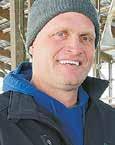

The digesters receive manure from four dairy farms. The rst is Maassen dairy, a 2,000-cow dairy operated by Aaron Maassen and partners, Adam, Stefan and Lee Maassen, near Maurice. The other three sites are operated by the Hoogland family. Two of the Hoogland dairies are located near Orange City and one is located near Maurice. There are a total of 4,500 cows milked at the Hoogland family’s three sites.
One digester is located on Maassen’s farm, which processes manure from his cows and one of the Hoogland farms. The other is located at one of the Hoogland dairies.
“I’m just happy that we’ve gotten to this point and it’s operating and producing gas,” Maassen said. “That’s exciting. I give Novilla RNG a lot of credit for following through with it and how they’ve gone through the construction phase.”
Digesters were originally used in water treatment plants. Dairies started utilizing digesters in the 1970s but became popular on dairies beginning in the 1990s. At rst the gas was used to run an engine to generate electricity. Now they have evolved into making puried renewable natural gas to power cities.
“This is like a dream,” Diane Herzog said. She and her husband, Allen, and their sons, Matt and Nick, milk 142 cows in a double-12 parallel parlor and house them in a freestall barn. The new freestall barn, which is split into two pens, has one feed lane.
Turn
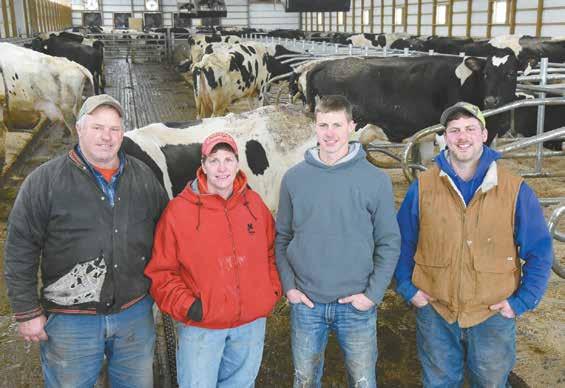
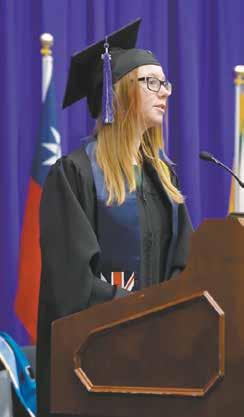
By Amy Kyllo amy.k@star-pub.com
KELLOGG, Minn. — For Monica Evers, the Winona State University December 2024 student commencement speaker, the address was all about the biggest life lesson she has learned as a dairy farmer: gratitude.
Evers is the daughter of Jerry and Tammy Evers. She is part of Evers Dairy, which milks around 2,600 cows near Kellogg.
Evers, a 4.0 GPA student and the top graduate of her department, earned
her degree Dec. 13, 2024, with a double major in mathematics and secondary math education. Evers was a commuter student who took a full course load of 15-20 credits a semester while feeding calves every evening at the family farm.
“Graduation was denitely one of the best days of my entire life,” Evers said. “Just being up there with how much work that I put in I thought, ‘This is nally paying off all of the hours that I spent in school on the farm at the same time.’”
Turn to EVERS | Page 7
Published by Star Publications LLC
General Manager/Editor
Mark Klaphake - mark.k@dairystar.com
320-352-6303 (ofce) 320-248-3196 (cell) 320-352-0062 (home) Ad Composition - 320-352-6303
Nancy Powell • nancy.p@dairystar.com
Karen Knoblach • karen.k@star-pub.com
Annika Gunderson • annika@star-pub.com Editorial Staff
Stacey Smart - Assistant Editor 262-442-6666 • stacey.s@dairystar.com
Danielle Nauman - Staff Writer 608-487-1101 • danielle.n@dairystar.com
Dan Wacker - Staff Writer 608-487-3858 • dan.w@dairystar.com
Tiffany Klaphake - Staff Writer 320-352-6303 • tiffany.k@dairystar.com
Amy Kyllo - Staff Writer amy.k@star-pub.com
Emily Breth - Staff Writer emily.b@star-pub.com
Sarah Middendorf - Staff Writer sarah.m@star-pub.com
Advertising Sales
Main Ofce: 320-352-6303 Fax: 320-352-5647
Deadline is 5 p.m. of the Friday the week before publication Sales Manager - Joyce Frericks 320-352-6303 • joyce@saukherald.com
National Sales Manager - Laura Seljan (National Advertising, SE MN) 507-250-2217 • fax: 507-634-4413
laura.s@dairystar.com
Assistant Sales Manager - Kati Schafer (Northeast WI and Upper MI) 920-979-5284 • kati.s@dairystar.com
Adam McClary (SW MN, NW Iowa, SD, Nebraska) 605-951-5270 • adam.m@dairystar.com
Mike Schafer (Central, South Central MN) 320-894-7825 • mike.s@dairystar.com
Hannah Ullom (Western Wisconsin) 715-933-4045 • hannah.u@dairystar.com
Keya Sleister (Eastern IA, Southwest WI, IL) 563-608-5988 • keya.s@dairystar.com
Julia Merten (Southeast MN and Northeast IA) 507-438-7739 • julia.m@star-pub.com
Bob Leukam (Northern MN, East Central MN) 320-260-1248 (cell) bob.l@star-pub.com
Mark Klaphake (Western MN) 320-352-6303 (ofce) • 320-248-3196 (cell)
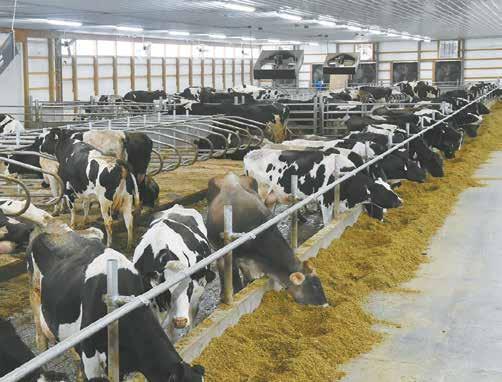
The 170 stalls are in three rows and are bedded with sawdust. The barn also has tunnel ventilation with ve 60-inch fans and three 36-inch fans. With overstocking, the barn has a capacity for 200 cows.
“It was the idea to grow the herd a little bit more,” Nick said.
Before building the new barn the Herzogs were milking at two different locations. Allen and Diane owned a 65cow herd on their home site and Matt and Nick partnered in 72 cows housed at a
neighboring site. As of Jan. 1, Matt and Nick have full ownership of all the cows on the farm.
“(The cows) thought they were in heaven (in) this new barn,” Diane said.
The barn-building process started in spring 2021 when they worked on the feedlot paperwork to get permits for the animals. In spring 2023, the family started working on plans and paperwork for the building. In November 2023, they put poles in the ground.
and only publication of an advertisement shall constitute
nal acceptance of the advertiser's order.
Letters Letters and articles of opinion are welcomed. Letters must be signed and include address and phone number. We reserve the right to edit lengthy letters. The
MARK KLAPHAKE/DAIRY
Cows eat at the bunk Jan. 2 in their new barn at the Herzogs dairy farm near Freeport, Minnesota. The Herzogs milk 142 cows in a double-12 parallel parlor.
During the building process, Matt and Nick spent many hours turning the design of the barn into a reality. With help from Matt’s old boss, Jay Blenker, of Blenker Construction and Concrete, and the warm winter last year, they were able to complete the construction in about a year.
“There wasn’t a day we couldn’t work on it,” Nick said.
With help from farmer friends, they poured 70% of the concrete. All the framing on the outside was done by Matt and Nick. Blenker helped with the poles and rafters and other big projects on the barn along with giving guidance when needed.
The family poured walls until Christmas 2023. In January 2024, Blenker came and helped them put the rafters up and the roof on. From there Matt and Nick worked on the walls and did the outside steel. This meant the building was fully enclosed during the spring so they could work on it even when it was raining. By April 2024, they were digging water lines and anything underground as well as working on the electrical wiring. In June 2024, they were pouring manure lanes.










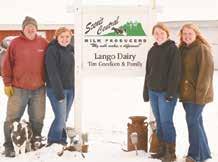
Hopkinton,


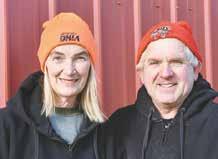
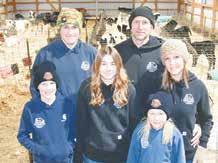
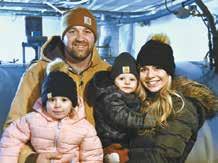
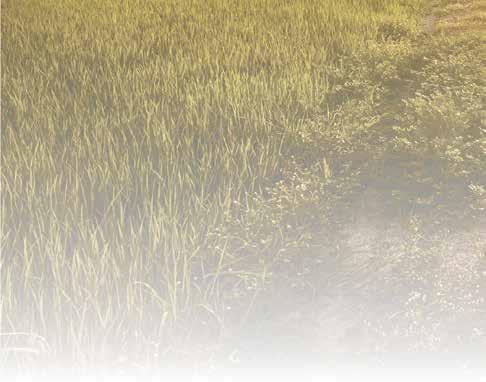
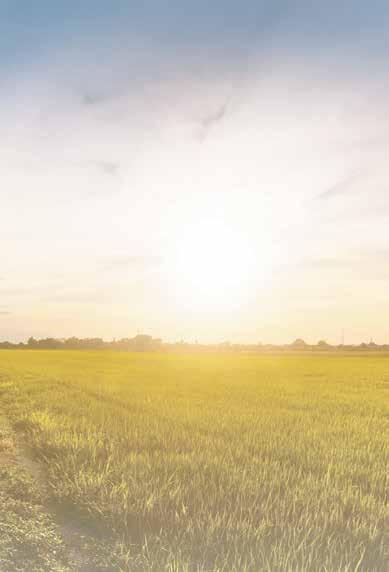


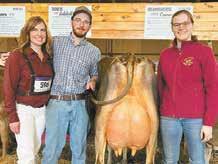
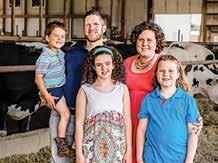
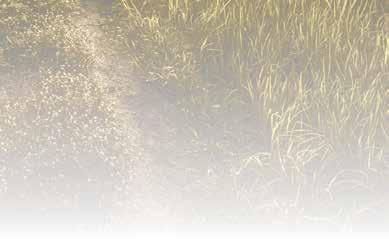
stories from our other zone, log on to www.dairystar.com

























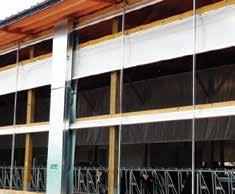








“We were tired the whole time,” Matt said.
They would often work late into the night preparing things for the following day.
“Someone’s coming the next day, so you have to get it ready before they come right away at 8 in the morning,” Nick said.
When they nished the rst half of the barn, they put eight heifers on that side of the barn to make it easier for the cows to go inside the new building. They moved the cows into the new barn Nov. 18, 2024, for the rst milking.
“From the way everybody was talking we thought … we’re going to be carrying the cows in there,” Allen said.
The Herzogs did not know what to expect or how the cows would react to the new facility.
“It was kind of scary because
everybody said it was going to take so long to teach them,” Diane said.
When the cows were fully moved in, they ran the chain scraper continuously to prevent the cows from lying in the alley. There were only two cows that laid in the alley, an act they were able to correct within three days.
“We were expecting the worst and it went very well,” Nick said.
One pen in the barn houses the herd that was previously owned by Allen and Diane and the other holds the cows the brothers brought.
During the transition into the new barn, there were challenges to overcome. The brothers’ herd had feet issues since they were on mats all day at their previous location. Matt said they put biotin in the total mixed ration a couple of months before and trimmed their hooves before moving them into the new barn. They
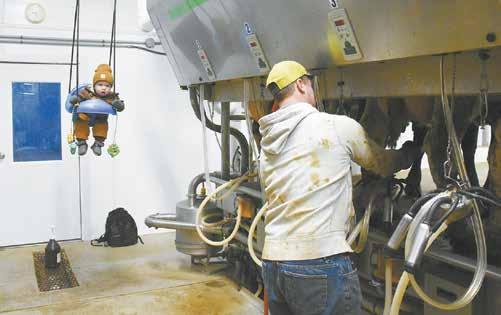
MARK KLAPHAKE/DAIRY STAR
Ma Herzog milks cows while his son, James, looks on Jan. 2 in their new barn at Herzog’s dairy farm near Freeport, Minnesota. The Herzogs can milk all the cows in about 90 minutes.


said the biotin was to help strengthen the cows’ hooves before the move.
“(After moving into the new barn) we hoof trimmed them every other day for about two weeks,” Matt said.
Matt and Nick were expecting the rst couple of milkings to take 4-5 hours, but to their surprise, they took 2.53 hours. Now they are able to milk the cows in approximately 90 minutes. They can milk all the cows in the new barn faster than milking both groups of cows in two separate barns.
Since Matt and Nick have full ownership of the cows on the farm, it allows Allen and Diane to pull back.
“The nice thing is we can step back and we know the work’s going to get done,” Allen said.
Throughout the different transitions, the Herzog family has put in hours of work to accomplish their goals.
“I wish I could have been … the person that stood back (and watched),” Matt said. “When you’re doing it, you don’t realize the progress you’re getting.”



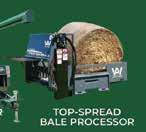

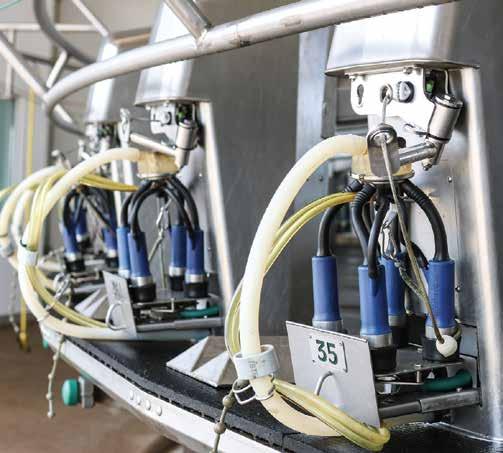
















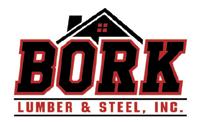




Mark Hill, co-CEO of Novilla RNG, said the West Branch project has been operating smoothly since they started it last fall. Novilla RNG has been around for three years and is run by Hill and Jared Williams.
Novilla RNG is currently in the process of building ve more RNG sites. The rst step taken is going out to the farm to understand how the producer handles manure so they know what they will need to make it successful.
The company has four operating systems and partnerships with nine dairy farms. The latest partnership is the dairies of the West Branch project.
“In December 2024, 99% of the time we were injecting gas into the pipeline to Sioux Center,” Hill said. “It takes a couple of months to get the digester warmed up and get the bugs right in there that are eating the manure and releasing the biogas.”
The pipeline and gas are closely monitored by Novilla RNG and people in Sioux Center. Hill said they have fewer emissions with the methane gas collected from the digesters than normal geological gas.

As production goes into full swing, the digesters will be producing over 140,000 million British thermal units a year. The natural gas captured by these digesters is utilized to power the digesters themselves and the excess is brought to Sioux Center with the use of a six-inch natural gas pipeline. According to the U.S. Department of Energy, a household will average 77 million Btu a year, meaning the digesters could provide natural gas to around 2,000 homes.
“I think the biggest positive right now is the size and scope of the project between multi-sites and all the different things that had to come together to make it work,” Maassen said.
The day-to-day operations of the RNG digesters are fully operated by
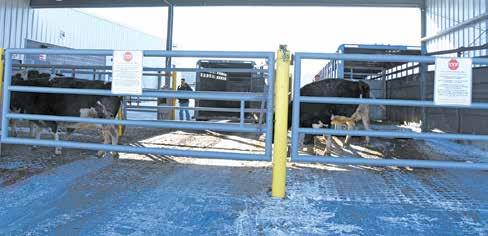
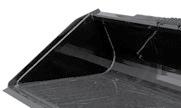


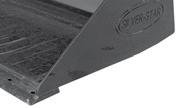
employees of Novilla RNG who communicate with the dairies so they can make adjustments to ensure the proper functioning of the digesters.
“The (start-up has) been smooth,” Maassen said “There’s some adjustments about water that needs to be added to help the sand get cleaned (out of the manure). It’s just a day-today operation of maintaining the bacteria and digester.”
At the dairies, most of the water from the manure is drained out and gets cycled back to the dairy to be reused to remove sand from the manure. In Maassen’s case, this is used to charge his sand settling lane.
“We’ve always had a sand lane, so essentially, they just rerouted the ow from the end of the sand lane into their facility to dewater it and separate the solids out to go into the digester.”
Once the digested manure, called digestate, is returned to the farm, the farmers can utilize it in the manner they always have. There are several positives of using digestate.
“One of the big benets at the farms is we help reduce odors that would be coming out of the lagoon because … the manure goes to the lagoon and sits there and in the summer months it will get hot and release gas and some of those gasses can be smelly,” Hill said.
The digestate also offers more plant-available nutrients since it has already been digested once.
Hill said the project has come together due to the cooperation of everyone involved.
“It has been great working with the city of Sioux Center,” Hill said “It is neat when you have a local community looking at unconventional ways of getting gas through their lines. Our project would not have happened if we were not able to work cooperatively with Sioux Center.”






Evers started her speech with congratulations to the graduates before jumping into some of the lessons she has learned on the farm, including discipline and compassion, but most of all — gratitude.
Evers shared some of the things people are often grateful for, such as the people in their life or the opportunities they have received. However, her focus was on encouraging graduates to be grateful to someone they may have forgotten: themselves.
“You are the person that put in all of this work,” Evers said. “You wake up every morning. (You) decide to go to your classes. You decided, ‘I’m going to graduate.’”
Evers said this gratitude perspective stemmed from the dairy farm where work happens every day to feed the world. Throughout her college career, both the dairy farm and college were intertwined.
“If I had a bad day at school, I’d go and do chores because that made me feel better,” Evers said. “If it’s a hard day on the farm the night before I’d go to school and be with my friends. It was a really good balance.”
Evers said her study friends learned to expect that she would go through the homework later in the evening because she was out doing chores.
Being a commuter made making close friends more difcult Evers said, but she

found a way.
“I’m outgoing enough, I would say, ‘Hi, I’m Monica. I’m a dairy farmer,’” she said.
At commencement, Evers walked in with faculty and staff and sat on the stage. As she watched her fellow graduates le in, she said she became nervous.
“I thought, ‘Yeah, this is cool for me, but this is their graduation too,’” Evers said.
Evers said her speech was well received.
“I didn’t write my speech to make people cry — not that heartfelt — but just (to be) impactful,” Evers said. “The goal of my speech is for the
students to hear something that they would take with them.”
Evers said she rst got the idea of being commencement speaker after listening to one of her friends give the speech at graduation last spring. However, when it came time to apply, Evers pushed it off. Applications were due Sunday,
Oct. 13, 2024, at 11 p.m. Evers turned in her application at 10 p.m. By that Friday she had given her speech before a panel of students and had been chosen as the speaker.
“I’m a big believer in, you miss 100% of the shots that you don’t take — just do it,” Evers said.
Her dairy career goes back long before college. Evers has been continually active on the farm since she was about 12 years old.
“I vividly remember that day I thought, ‘I’m going to feed calves by myself, and I’m going to tell Dad so I can start being a farmer like him,’” Evers said.
From that rst time feeding calves, Evers has continued whether it was sitting in the feed bunk checking off ear tag numbers while her family sorted cattle or feeding calves in the facility Evers Dairy built in 2019.
Evers said her rst weekend at Winona State University she decided to try spending the weekend away.
“I thought, ‘I can’t be away from the farm,’” Evers said. “Not being with the cows really was not my thing.”
Evers said she continues to want the dairy to be part of her life. She will be substitute teaching through June before pursuing a full-time position. She plans to help on the farm during weekends and summer breaks.






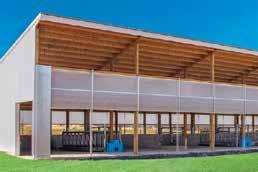





By Dan Wacker dan.w@dairystar.com
HOPKINTON, Iowa — Just off Quarter Road in Hopkinton sits Lango Dairy, a 170-cow dairy owned by Tim Goedken. The rst-generation farm was founded in 1992 as a 44-cow tiestall operation. Goedken has expanded the herd to its current size and now milks in a double-8 parabone swing parlor. He is passing the business to his daughters: twins, Sarah and Tara, and their younger sister, Courtney.
“They’ve always been involved and had their responsibilities on the farm, so I hoped that one day maybe one of them would come back,” Tim said. “Even when they were at college, they kept showing interest in what I was doing. My rst thought when they wanted to come back (was that) I was relieved.”
Sarah graduated from Northeast Iowa Community College with a degree in dairy and animal science. Tara graduated from Kirkwood Community College with a degree in agriculture business. After college, Sarah dove in full time on the farm, and Tara split time at Lango Dairy and Vermazen Tax Service in Manchester. Courtney graduated from Kirkwood Community College in May with an agriculture busi-
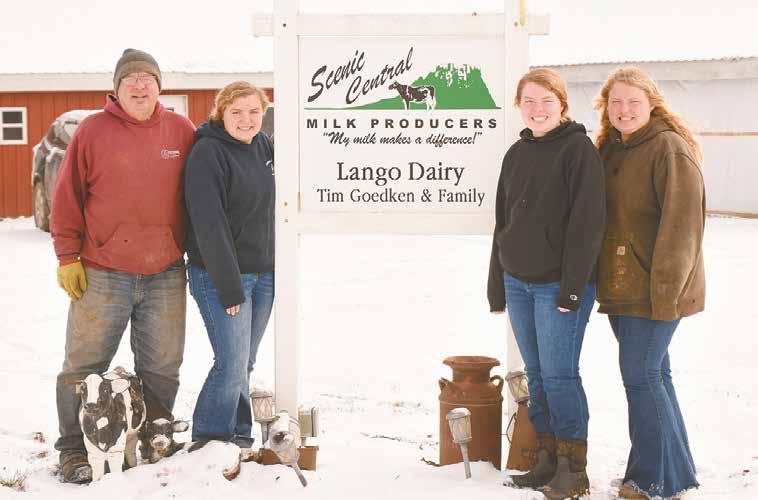
Tim (from le ), Courtney, Tara and Sarah Goedken gather Dec. 18, 2024, on their farm near Hopkinton, Iowa. Goedken’s daughters have come back to the 170-cow dairy a er earning college degrees.
ness degree. She also returned to farm with her dad and sisters while working off the farm at Triangle Agri Services in Monticello.
Sarah has taken on the herdsman role. Tara works with calves, milks
and uses her accounting background to keep farm records. Courtney works primarily with the calves and milks, while assisting Sarah where needed. Tim still handles the feeding and crops.
Sarah and her sisters realize the op-
portunity that is in front of them.
“It’s very benecial for us to have a place we can come back and start working at,” Sarah said. Turn to GOEDKENS | Page 9































































“It was nice to get away, learn and meet new people and now come back. It’s a little crazy that we’re doing this, and have this opportunity at 22 and 21 years old. It’s very humbling and we’re proud of where we come from. That’s why we want to come back and work here again.”
The sisters bring with them new ideas and practices they have picked up along the way. With new ideas comes new challenges and a growing level of trust between an experienced generation, and one eager to implement change.
“You don’t want to switch things up too fast,” Tim said. “Its tough to transition away from things that have worked, but maybe weren’t as efcient.”
One of the rst changes the sisters made was applying for a Choose Iowa Grant. Lango Dairy used that grant to purchase a Milk Taxi to complete the new calf barn addition that was started in 2023. They also used the grant to purchase Alta Cow Watch collars. Bringing in new technology to the farm was something the younger Goedkens wanted to implement as soon as they could.
“Before the taxi and the collars, the idea of technology like that coming to the farm was a bit foreign,” Sarah said. “We would have tried to work towards it, but Tara put in the work to ll out the application and I can’t see us ever going without it again.”
Tim is gaining condence in the plans of his daughters.
“It’s tough to try and let go, but I trust them,” Tim said. “They are the future, so I’m a lot better at trusting them now than I used to be.”
Along with learning to trust have come opportunities to further educate
and learn from decisions that were not as successful as projected.
“If we do something different than what we’ve done in the past and it fails, it becomes a teaching moment,” Sarah said. “We learn from it so we can be better. If we change something and it does well, good. But if it doesn’t do as well, we can learn from it and do better next time.”
That eagerness to learn from each other is an important aspect of the working relationship between the father and his daughters. It also has led to a better understanding of how to work with one another.
“Sometimes we can butt heads, but that’s when we realize how important communication is,” Tara said. “We’ve done things a certain way for a long time, and if you’re trying to change that, you need to communicate why you think your way is going to improve on what we’re doing.”
What brought the sisters back to the farm was the connection with each other and the farm. That especially rang true for the twins.
“When we rst went to school and split up, it wasn’t easy being away from the farm or each other,” Tara said. “You had to go out in your own world. It was hard to be away. We always enjoyed each other and being outside together, so I always hoped we could come back and work the farm together.”
For Tim, the girls came at just the right time.
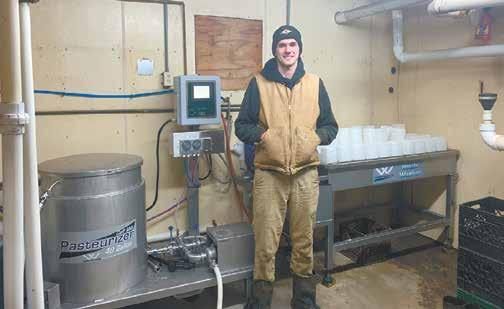


“We began looking at a bottle washer to keep bottles cleaner and eliminate an extra job. After seeing the option to purchase the bottle washer and pasteurizer combination, we started to look at its benefits. Once we calculated what we would save by not buying bags of milk replacers, it was an easy decision to add the pasteurizer. Since installing the new system of the bottle washer and pasteurizer combination the calves drink better and are healthier.”
“I got pretty burnt out there when the girls were all in college,” Tim said. “I was trying to do it all on my own with some help from some high school workers, and it became exhausting. To have them back here, I can’t explain what it means to me.” (800) 887-4634
Higher feed intakes Higher milk yields Higher farm profits
Don’t just push feed, remix it with DeLaval OptiDuo™. Instead of compressing feed, we remix it - making it much more appetizing for cows. Ideal for farms operating a onceper-day feeding frequency.

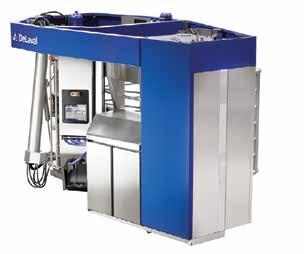


A milking robot from the VMS V300 series offers the best milking process we have ever created, maximizing the economic benefit of every visit your cows make to it. It allows each cow to be milked to her individual needs and capacity, meaning each cow reaches their full potential.





The U.S. Department of Agriculture has established a goal of eradicating the H5N1 virus from the U.S. dairy herd. Lucas Sjostrom, a member of the government affairs team for Edge Cooperative, admits this is a new endeavor. “Dairy farmers (and) our poultry industry would all love this disease not to be affecting us, but what’s the best and most effective way to do that?” That’s where we’re trying to help our processors and our farmers gure out what is the most effective way to get to that goal.” Ultimately, Sjostrom said it is important to preserve the dairy industry’s export markets. “I hope dairy farmers realize whether you ship to the cheese plant down the road or one that’s shipping to Mexico every single day, this affects our milk price no matter who you are and where you are.”
Additional states added for milk testing
the total funding for the program to over $31 million. Payments will be based on 2023 or projected 2024 marketing costs.
The only three-term agriculture secretary

By Don Wick Columnist Ag Insider
USDA has announced the second round of states participating in its National Milk Testing Strategy. Seven states were added to the 13 original states being tested. The agriculture department requires raw unpasteurized milk samples to be tested for the H5N1 virus. At this point, Minnesota is not part of the surveillance effort.
High beef cattle prices inuencing dairy markets
The rebuilding of the U.S. beef herd remains nonexistent. USDA Chief Economist Seth Meyer said that is also being felt in the dairy market. “On the dairy side, protability has been good over the last year, but the ability to expand and respond to any protability has been hampered by that same contraction in the beef herd. It has made beef-dairy crosses for dairy heifers protable as well, so we may be a little short on the purebred dairy heifers needed to expand the herd.”
Farm bill future
Agriculture Secretary Tom Vilsack has served 12 years in that role, longer than any other person. Vilsack led USDA during the Obama and Biden administrations. “I’m just extraordinarily proud of the work that we did, a consistency of commitment to very critically important responsibilities and missions of USDA.” Vilsack’s legacy has been the focus on small and medium-sized farms.
Olson retires
AgCountry Farm Credit Services Senior Vice President of Government and Public Affairs Howard Olson retired at the end of the year. Olson had been with AgCountry for 27 years.
Farm Credit Council selects Seyfert
The Farm Credit Council has named Christy Seyfert as its president and chief executive ofcer. Seyfert is now the executive director of government affairs for the American Soybean Association. She will begin her new role in mid-January.
Farm Credit Administration names Mosely for Ofce of Congressional and Public Affairs
Ben Mosely is the Farm Credit Administration’s Ofce of Congressional and Public Affairs director. Most recently, Mosely was a principal at a government affairs group known as the Majority Group. Previously, Mosely worked for the USA Rice Federation and on the Senate Agriculture Committee staff.
New leadership for Holstein USA
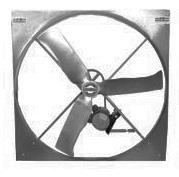


• The highest air ow in a circulation fan - 33,900 CFM.
• Cast aluminum blades have a lifetime warranty.
• Totally enclosed maintenance free, high ef ciency motors have a full two year warranty. Model VP CA:


The new Congress is in place and a new farm bill will be on the radar. “We’ve been kicking the can down the road for quite some time,” said Sam Kieffer, vice president of public policy, American Farm Bureau. “The 2018 farm bill technically expired two years ago and here we are still operating under shortterm extensions.” Kieffer believes Minnesota Senator Amy Klobuchar and Minnesota Representative Angie Craig will help move a modernized farm bill forward. Klobuchar is the new ranking member of the Senate Agriculture Committee and Craig is the new ranking member on the House Ag Committee.
Disaster relief payment rates updated
Ahead of the Christmas holiday, Congress passed a funding bill to avert a government shutdown, extended the farm bill for another year and provided farmers with economic assistance. Green Solutions Group farm management analyst Kent Thiesse said the 2025 economic outlook pushed Congress to action. “There was a survey about a month ago of ag lenders and 80% of them either said we were in a recession or headed toward a recession in 2025.” Disaster relief payment rates also received an update. “This will be based on actual planted acres in 2024 as reported to FSA ofces and for farmers that maybe have preventive planted acres, half of those acres would also count.”
Milk production tightens slightly
U.S. milk production totaled 17.9 billion pounds in November. That’s down 1% from a year ago. Minnesota’s milk production was unchanged, but cow numbers declined by 7,000 head. In South Dakota, milk production increased 1% while the size of the dairy herd declined by 1%.
USDA boosts support for organic dairy producers
USDA is allocating an extra $8.7 million to help organic dairy farmers offset rising costs and market instability. The money is part of the Organic Dairy Marketing Assistance program for 2024. This brings
Lindsey Worden is the new CEO for Holstein Association USA. Worden has been with Holstein USA for 17 years, starting as a college intern. After college, Worden joined the organization as its public relations specialist. She later served as the communications manager, the executive director of the Holstein genetic services department and chief operating ofcer. Worden succeeds John Meyer, who was with Holstein USA for 23 years.
Dziedzic passes
Former Minnesota Senate Majority Leader Kari Dziedzic, 62, passed away on Friday. Dziedzic stepped down as the caucus leader in 2022 after receiving her cancer diagnosis. Dziedzic represented Minneapolis in the legislature. Previously, she was the executive assistant to Minnesota Senator Paul Wellstone
Acker passes
Duane Acker, who was part of USDA during the presidency of George H.W. Bush, has died. Acker served as USDA’s assistant secretary for science and education and was the head of the Foreign Agricultural Service. Earlier in his career, Acker was the dean of agriculture and director of extension for South Dakota State University, associate dean of agriculture and later president of Kansas State University.
Trivia challenge
The tradition of leaving milk and cookies for Santa Claus began during the Great Depression in the 1930s. That answers our last trivia question. For this week’s trivia, who served as Jimmy Carter’s agriculture secretary? We’ll have the answer in our next edition of the Dairy Star.
Don Wick is owner/broadcaster for the Red River Farm Network of Grand Forks, North Dakota. Wick has been recognized as the National Farm Broadcaster of the Year and served as president of the National Association of Farm Broadcasting. Don and his wife, Kolleen, have two sons, Tony and Sam, and ve grandchildren, Aiden, Piper, Adrienne, Aurora and Sterling.
Listed below are the most popular stories published on our website in 2024
1.
A shock to the system
Total views: 35,930
First-generation dairy farmers Dylan and Bryanna Handel had an unexpected halt in their dream. One evening they went to milk cows and their normally docile cows were acting strange. Low and behold there was stray voltage on the farm from a new substation nearby. This caused the cows to rise in somatic cell count, drop in milk production, abort calves and become unhealthy. After working with the electrical company, the voltage was reduced but the health problems were not. The couple is still trying to nd a solution to this problem.
2.
A cruel twist of fate
Total views: 22,612
Lexi Anderson, an avid Jersey showman from Cumberland, Wisconsin, was playing basketball one minute and the next she was unexpectedly diagnosed with a rare heart disease and added to the heart transplant list. Lexi was experiencing symptoms during a basketball game so her parents, Jamie and Tamala Anderson, made a doctor’s appointment. During that appointment, an electrocardiogram revealed that Lexi had restrictive cardiomyopathy. Even with the disease, Lexi was still able to show dairy and sheep at the Barron County Fair in Wisconsin. She hoped to be able to show at the Minnesota State Fair and World Dairy Expo as well.
5.
Total views: 4,505
Wildlife animals caused damage for many farmers in the north woods of Wisconsin. Mike Robers, a Sawyer County dairy farmer, and Dale and Connor Beissel, of Winter, experienced deer and bear damage rsthand. Farmers can enroll in a Wildlife Damage Abatement and Claims Program, but the program does not cover the full extent of damages. With the program, farmers must meet specic criteria. According to Robers and Dale, farmers are capped at $10,000 for crop damage reimbursement.
Starting from scratch
Total views: 3,442
Following their passion has allowed brothers Justin and Jared Roberts to expand their dairy and start selling milk near Cataract, Wisconsin. In 2017 their mom, Kelly Merow, decided to sell the herd. The brothers took that time to gain experience on a larger farm. Four years ago, their goal to dairy farm became a reality. They purchased ve heifers, milking them in an old pig barn with a show pump. Then, Justin purchased a site with a building they could renovate, and they are now milking their 17 cows in a 20-stall tiestall barn with four box stalls.
Koesters focus on genetics to achieve high production
Total views: 3,226
Dan and Amber Koester along with their children — Lance, Kyle, Brent and Bria — as well as Lance’s wife, Cynthia milk 400 cows near Dakota, Illinois. The cows are housed in a 6-row sand-bedded freestall barn and milked in a double-12 parlor. The farm currently milks three times a day and has a herd average of 35,493 pounds of milk. Their cows are dry for seven weeks and housed in the freestall barn. The herd’s somatic cell count averages between 100,000-150,000. The Koesters are currently using SenseHub activity monitors to provide health and reproduction alerts.
3. 4.
Growing from the ground up
Total views: 6,897
Growing up as a crop farmer but having a passion for dairy cows led Corey Metcalf to grow his dairy herd. Corey farms near Milton, Wisconsin, with his wife, Kristen, his parents, Terry and Jane, and help from his sister, Lauren. The family was able to double their herd within six years and now milks 750 cows. They built the barn with cow comfort in mind. Creating cows that are well-balanced and long-lasting is a goal for Corey.
42-year dairy career comes to a close
Total views: 4,694
After 42 years of milking cows, Richard and Sara Larson of Alma Center, Wisconsin, decided to sell their 26cow herd in April 2024. Richard’s dairy farming career began when he was 16 years old and decided to purchase the farm July 8, 1981. Richard and Sara were married in 1995 and a couple of years later the herd grew to 50 cows, which they were milking with Jon, Richards’s brother, at his farm. Through some unexpected health events with Jon, the Larsons ultimately renovated their barn and started milking their herd separately again.
6. 7.
Her favorite place to be
Total views: 4,437
As if one herd wasn’t enough, Madalyn Nielsen, of Lake Mills, Wisconsin, manages two herds — farm A and farm B. Nielsen has known she wanted to farm since she was 3 years old. Farm A has 65 cows housed in a tiestall barn and milked by six units. At Farm B, 80 cows are housed in sand-bedded free stalls and milked in a 52-stall stanchion barn. Nielsen strives to keep the cows clean to produce quality milk.
Total views: 3,764
Keeping the next generation in mind, Tom Kampsen and Becky Heinz of New London, Minnesota, renovated their tiestall barn into a parlor. The parlor is located where the rst 24 stalls used to be; while the holding area is where the other remaining stalls used to be. The couple now milks the herd in their new double-7 parlor. Throughout the renovation process they had family and friends who were willing to help with different tasks. The couple put in many late nights and early mornings to reach their goal.
Six generations keep farm in family
Total views: 3,499
Colette (Diers) Thorson and her husband, Andy, are fth-generation farmers at Diers Corporation near Waverly, Minnesota. The farm has seen many generations and is welcoming a sixth generation as well. The farm is still using buildings that were built in 1920. Collette wanted to take over the farm since she was in high school. Since meeting her husband, who also wanted to dairy farm, they have been able to accomplish that dream.
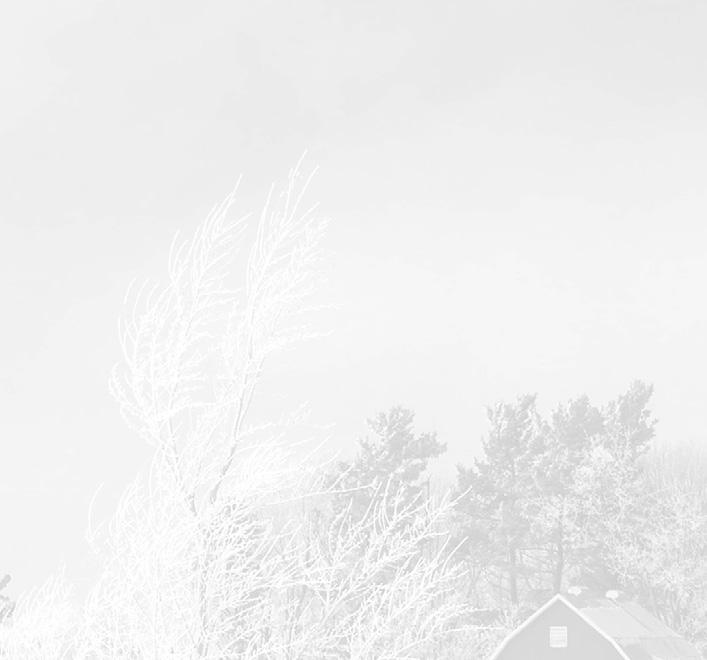
8. 9. 10.

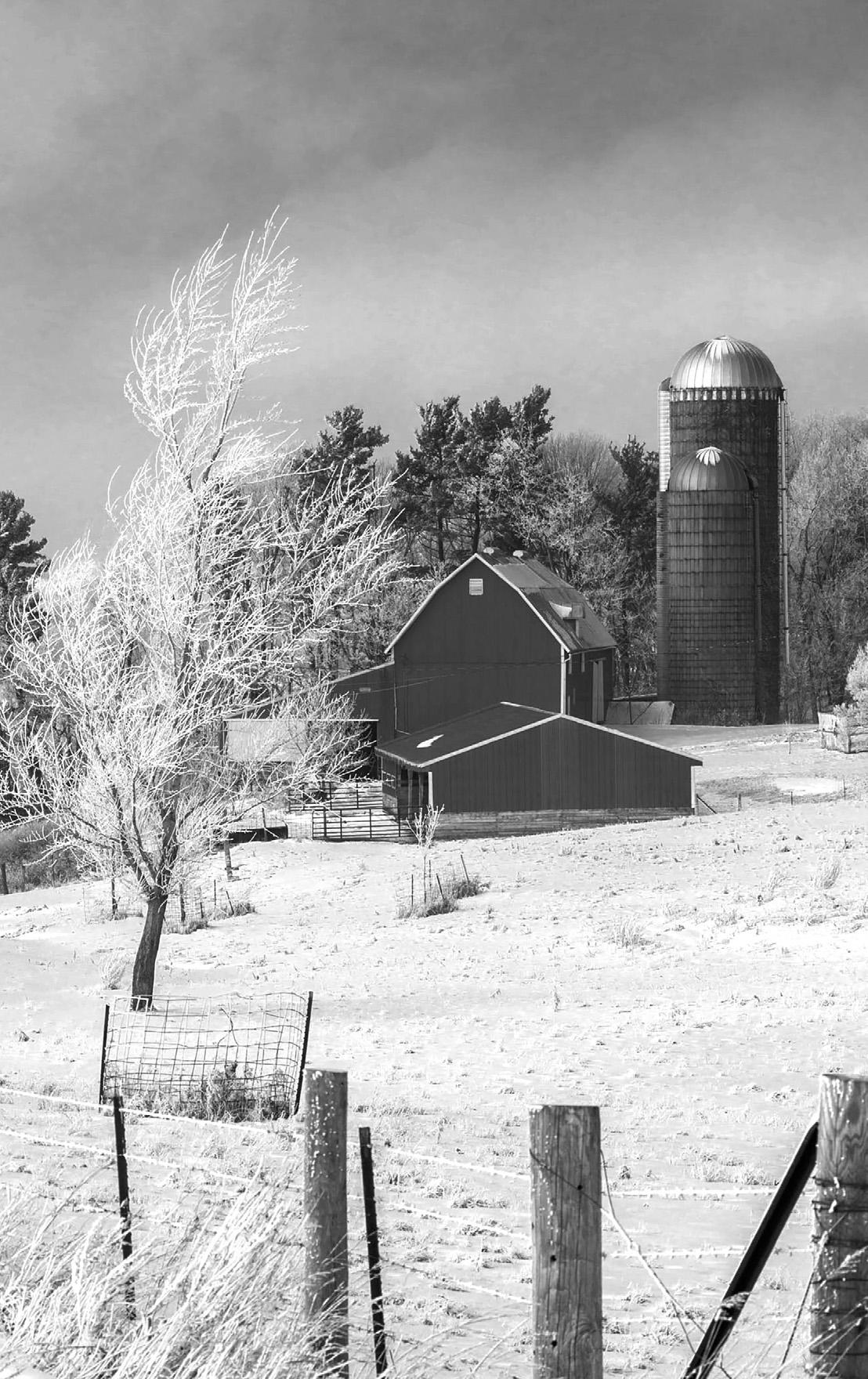
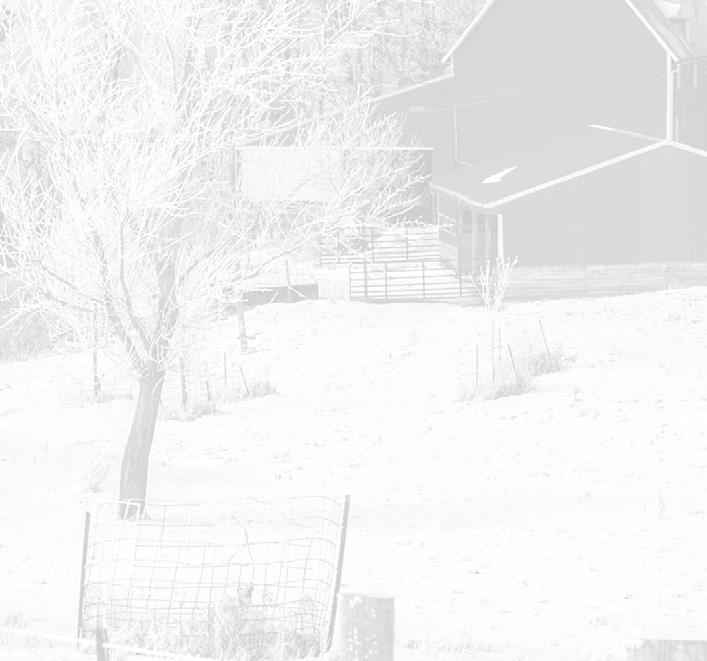
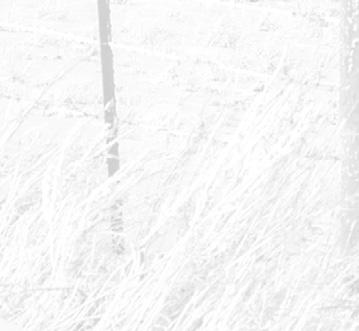






“We like the DHIA tags because we can get them customized to what we want.”
What do you like about the tags you order from DHIA? We like the DHIA tags because we can get them custom to what we want on them: birthdate, sire, dam, etc. We also get the RFID and genomic tissue sampler with the tags.
Tell us about the convenience of going through DHIA for your ear tags. The process is very simple because our DHIA milk tester orders the tags every month. It is very easy to go in and add the tag series into the software.
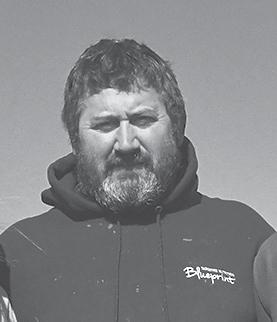
Cory Mulhern, Mulhern Dairy Fountain, Minnesota
1,000 cows • 45 years with DHIA
Is a good tag product important for managing data within your farm? Yes, this keeps it easy. The tags are easy to read the entire life of the cows and the tags stay in well.
Why is testing with DHIA important to your dairy? for breeding decisions and deciding on cull cows using energy-corrected milk and cell count.
Tell us about your farm. Mulhern Dairy started in 1970 and is a fourth-generation family run dairy farm.

Sauk Centre, MN Buffalo, MN 763.682.1091 www.mndhia.org



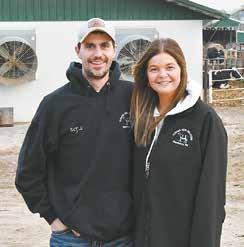
AMY KYLLO/DAIRY STAR
Marshall and Alyssa Friese stand outside the barn Jan. 5, 2024, at Rodash-View near Wanamingo, Minnesota. Marshall recovered a er being crushed between a skid loader and the unloader of the mixer June 12, 2023, and is back working on the dairy farm.
Marshall Friese was able to return to work on his family’s dairy farm after being laid up for months following
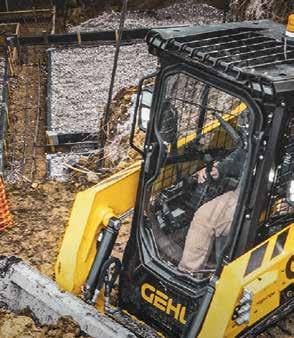

a farm accident. In June 2023, Friese was driving a skid loader to mix feed and reached up and out of the skid loader to adjust the mixer scale so he could see it better. While doing so, the skid loader crept forward and pinned Friese in between the skid loader and mixer. Friese was able to kick the skid loader into reverse so he could free himself and nd help. After multiple hospital stays and surgeries, Friese is back on the family farm near Wanamingo, Minnesota, mixing feed and helping with other chores.
State University dairy production facility will close in June 2024. The deciA look back at the top stories of

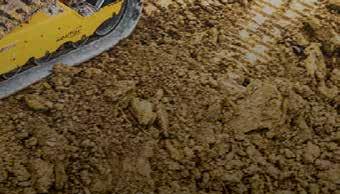

decrease in feed intake, reduced rumen motility and milk having a colostrum-like consistency. Wild migratory birds are believed to be the source of HPAI infection in dairy cattle. Dr. Keith Poulsen, director of the Wisconsin Veterinary Diagnostic Laboratory, said that cows are not dying from the disease, but are dropping in production for a period and then returning to normal. Poulsen also said all pasteurized milk and cooked meat is safe for consumption.
sion was made after stakeholders determined the facility was not viable and adequate funds could not be raised to build a new facility. The university will continue to offer the same programs and operate the Davis Dairy Plant, where students make cheese and ice cream onsite. The only change will be that the milk for the processing plant will be sourced from local dairy farms instead of the university’s own dairy cows.

In late March, dairy cows on farms in Texas, Kansas, New Mexico, Idaho, Michigan and Ohio began experiencing symptoms and death from an unknown illness. The illness has been identied as highly pathogenic avian inuenza. Symptoms include
Conrmed cases of highly pathogenic avian inuenza have been found in Minnesota, Iowa and Wyoming. This brings the total number of conrmed cases to 102 in 12 states. It has also been conrmed that three dairy farm workers have contracted the disease after being in contact with infected cattle. The Wisconsin Department of Agriculture, Trade and Consumer Protection issued an order that went into effect June 19 requiring all lactating dairy cattle moving within the state for show or exhibition to have a negative H5N1 test within seven days of being moved. The Minnesota Board of Animal Health issued an order going into effect June 18 that requires a negative test and a certicate of veterinary inspection for all lactating animals for in-state movement for shows.
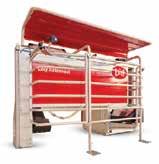

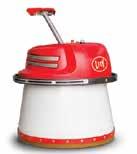

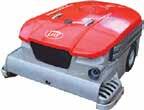



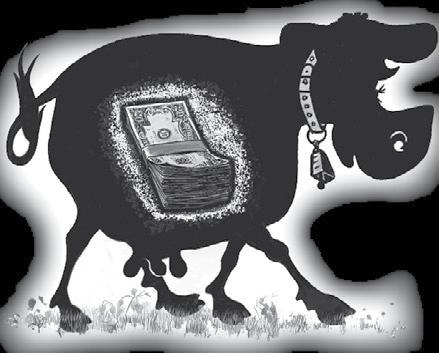



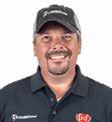
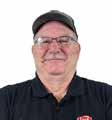
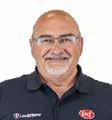



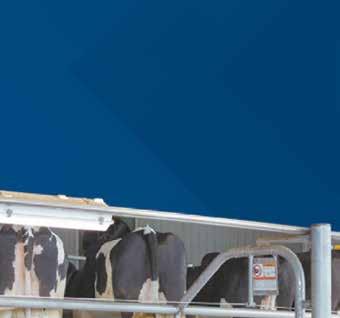






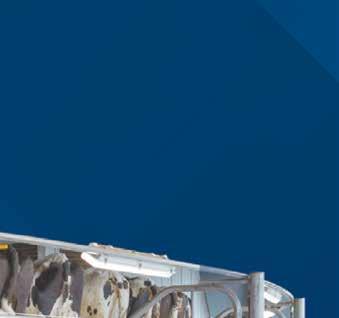










Aug. 10, 2024

AMY KYLLO/DAIRY STAR
Mark (le ) and Andrew Vagts look through court documents July 18, 2024, at Mark’s home near West Union, Iowa. The Vagts family was in the li ga on process for over three years.
Mark Vagts and his son, Andrew, milk 500 cows near West Union, Iowa. On June 21, 2024, litigation with Northern Natural Gas ended with a ruling in favor of the Vagts from the Iowa Supreme Court. Vagts Dairy LLC was awarded $4.75 million in damages due to stray voltage. This comes after a three-year lawsuit between the Vagts family and Northern Natural Gas company. The Vagts’ farm was affected by direct current stray voltage coming from a rectier, anode bed and nearby natural gas pipeline.
Aug. 24, 2024
Rachel Visser’s life changed forever Aug. 21, 2024, when she was crowned Princess Kay of the Milky Way. Visser is the 19-year-old daughter of Barry and Shannon Visser of Hutchinson, Minnesota. She is a

AMY KYLLO/DAIRY STAR
A crown is placed on the head of Rachel Visser as she stands between Ka e Ketchum (le ) and Grace Woitalla (right) Aug. 21, 2024, at the Minnesota State Fair in Falcon Heights, Minnesota. Visser was crowned the 71st Princess Kay of the Milky Way.
sophomore at the University of Minnesota majoring in agricultural and food business management and agricultural communications and marketing. The McLeod County native did not grow up on a farm but became active showing dairy cattle with Chad and Stacy Bohn, who own and operate Stadview dairy near Litcheld.
26, 2024

AMY KYLLO/DAIRY STAR
Memphis Franke (front), (back, from le ) Wayne Evers, Cory Henry, Tracy Franke and Kevin Franke smile Oct. 15, 2024, at Evers Dairy near Kellogg, Minnesota. Memphis Franke, who has Duchenne muscular dystrophy, likes to help on the dairy.
Nine-year-old Memphis Franke wants to be a dairy farmer when he grows up. But young Memphis was diagnosed with Duchenne muscular dystrophy, which causes muscle degeneration over time. He helps out and rides along as often as he can at his family’s dairy farm, Evers Dairy, near Kellogg, Minnesota. On Oct. 6, 2024, instead of riding along while the family was chopping he drove his John Deere-themed wheelchair that was hooked up to a Radio Flyer wagon and helped haul corn silage. He drove his load of silage from the eld, a quarter mile back to the farm to unload just like the rest of the haulers.
Dec. 7, 2024
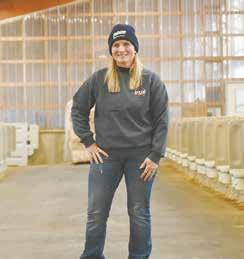
DAN WACKER/DAIRY STAR
Megan McAllister stands in her calf barn Nov. 19, 2024, on her farm near New Vienna, Iowa. McAllister has garnered a following on social media with her Megan DairyGirl proles as she educates people on daily life on a dairy farm.
Megan McAllister, also known as Megan DairyGirl on TikTok, Facebook and Instagram, has nearly 600,000 followers. McAllister uses social media to educate others about dairy farming. She grew up on a dairy farm and currently milks with her

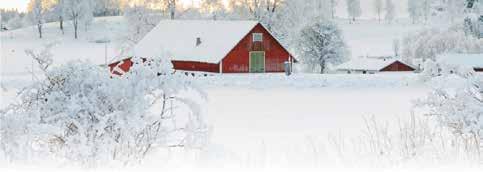
husband, Ted, and his brother, Rob, at McAllister Family Dairy, where they milk 280 cows in a double-12 parallel parlor near New Vienna, Iowa.
Dec. 21, 2024
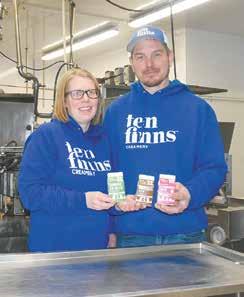
Joel and Amanda Hendrickson and their 13 children milk 145 cows and farm 440 acres at their farm near Menahga, Minnesota. The Hendricksons also own and operate an on-farm processing facility named Ten Finns Creamery. For the 2024-2025 school year, Ten Finns Creamery is supplying 10 local schools with milk. After Menahga superintendent Jay Kjos — who had not been able to drink milk — learned about Ten Finns’ production of A2A2 milk and was able to drink it, he invited other superintendents to visit Ten Finns and learn more about A2A2 milk and the creamery’s ability to supply it to area schools.

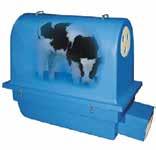


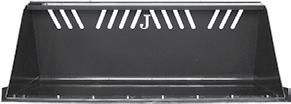

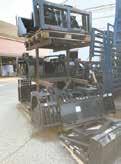
Andy
What is a goal for your farm this year?
Lejeune Viroqua,
Wisconsin Vernon County 80 cows
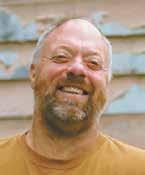
How many years have you been dairy farming and what do you enjoy about dairy farming? I have been farming for 29 years. I enjoy seeing our young animals come into the herd and grow and produce. Seeing those animals you help bring into the world grow up and become contributors to the herd is great to see.
What accomplishments did you have on the farm in 2024? In 2024, we had about 60%-70% heifer calves. We are strictly a bull-bred herd, so to have that number of heifers was denitely an accomplishment and something that we really enjoyed.
What is a goal for the farm this year? For 2025, we hope to expand our herd a bit, hopefully add 10 or 20 more. We want to do that by providing great care to the cows and the herd we have. We might purchase a couple, depending on what the price is, but our goal is to add to our herd through the great care we can provide on our farm.
What are you looking forward to this year? We are looking forward to staying healthy and watching our kids grow. My wife and I have four kids, ranging in age from 14 to 1. The youngest just started walking and they always like to keep us on the move. We are also looking forward to another good growing season and seeing our new heifers enter the herd. It is rewarding to bring up those heifers and see how they can contribute to the herd when they get old enough. Each year is different and presents different challenges, so seeing how we handle those as a family and as a farm is something we look forward to.
What do you foresee being a challenge in 2025? Weather is always a challenge because it is so unpredictable. We have a general idea, but sometimes it does not always stick to the plan. With those changes in weather, the spikes in respiratory illnesses can be a challenge. Input costs are rising on machinery and labor and parts seem to be going up, so that will always challenge us a bit.
Tony Hellermann Melrose, Minnesota Stearns County 65 cows
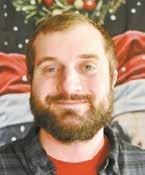
How many years have you been dairy farming and what do you enjoy about dairy farming? I been farming my whole life. I am in the process of buying the farm and started by buying the cows in 2021. I enjoy being my own boss and working alongside my family. We all enjoy raising the cattle from calf on and seeing them grow. We all take turns naming all the calves we have (even though Madison chooses most of the names before anyone else has a say in it).
What accomplishments did you have on the farm in 2024? In 2024, we were working on cow health management by keeping somatic cell count down and getting milk production up to keep producing a quality product for consumers.
What is a goal for the farm this year? Continue to improve cow management and see what is the most effective way to achieve that.
What are you looking forward to this year? A good year for crops and family along with everyone staying healthy.
What do you foresee being a challenge in 2025? Like every year, the uctuating milk price is always a challenge, not just for us but for everyone. Especially for the smaller farms, the impact of how much it uctuates makes a huge difference in what the plan is for each year.
Tell us about your farm. We are a 65cow tiestall operation north of Melrose. We raise all our replacements. Living on the farm are my parents, Donnie and Debbie, my stepdaughter, Madison Ainali, my wife, Brittany, and me. We all work together along with a lot of other family members who come to help throughout the year. We ship our milk to First District Association.
Tell us about your farm. My brother, Jeff, and my dad, Mike, and I work on our farm. We milk about 80 cows in a double-6 herringbone parlor. We sell to Westby Cooperative Creamery.
Duane Hager Kellogg, Minnesota Wabasha County 40 cows
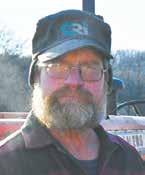
How many years have you been dairy farming and what do you enjoy about dairy farming? I will have dairy farmed for 40 years in three months. I enjoy being out every day. I like working with the cows most days. Right now, I’m looking to get out of dairy farming. My son, Wesley, is working with me and I’m enjoying that now and hoping he’ll carry the farm on.
What accomplishments did you have on the farm in 2024? We made a lot of hay. It was all in good shape despite the weather. We’re grazers so the pasture did well this summer. Physically, I was able to make it through another year (at 66, that gets to be a question.) The cows did well, too.
What is a goal for the farm this year? My goal is to become retired. I probably won’t really retire, but I will get it passed to my son. I want to work for him instead of him working for me. I want to stay active and step back but be able to help him get started. To accomplish passing it on will mean continuing like we are but being OK with giving over more responsibilities. I’ll let him come up with his own ideas on how he wants to continue the farm.
What are you looking forward to this year? I’m looking forward to stepping back. I’m looking forward to having good health and being able to be part of the farm. I’m looking forward to being able to spend more time enjoying my family and working with them. Basically, doing more of the things I want to do versus the things I have to do.
What do you foresee being a challenge in 2025? The thing that has always been the most challenging is not knowing where the dairy industry is going for sure. Weather is also a variable. In the dairy industry as a whole the prices are always variable. It’s hard to make decisions to compensate. In the dairy industry as a whole, you wonder whether this size of dairy can continue to be viable. I’m looking to get out of it so it doesn’t make a big difference to me. However, my concern is for my son. Will he have to make big changes to continue or possibly have to get out of it altogether?
Darvin Keehr Little Falls, Minnesota
Morrison County 43 cows
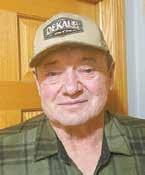
How many years have you been dairy farming and what do you enjoy about dairy farming? I have been farming all my life, as long as I can remember. I like that it is constant work and I am at home. I have never had to leave to go work somewhere else.
What accomplishments did you have on the farm in 2024? We had a really good crop. We have around 1,400 acres of corn, soybeans, hay and alfalfa and we did really well this year.
What is a goal for the farm this year? We are hoping to have a good crop again, as good as this year. We are just going to work in the elds more and hope for good weather.
What are you looking forward to this year? I am really hoping everyone is healthy, both the family and the cows. I am looking forward to the harvest again and, hopefully, we won't have to buy any feed again.
What do you foresee being a challenge in 2025? We want to see the prices stay up; they were really good this year and we want that to continue. It goes up and down and right now it is up, so hopefully it stays there.
Tell us about your farm. My wife, Beatrice, and I milk in the morning, and Beatrice and Andrew, our son, usually milk in the evening. We have a tiestall barn where we milk 43 cows using four milker units. We sell our milk to Bongards, but it actually goes to Melrose for cheese.
Tell us about your farm. We house our cows in a 40-stall tiestall barn. We ship our milk through National Farmers. The farm is operated by Wesley and me. In addition to the dairy, we have a 30 cow-calf pair beef herd. Overall, for the beef and dairy we have 100 acres of pasture. Our milk cows are rotationally grazed and are put on new pasture daily. We are not organic, but we lean towards organic. It will be up to my son whether he wants to take the farm organic. Our crops could be certied organic. Organic is the one thing I look at to keep this sized farm viable.



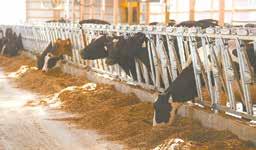


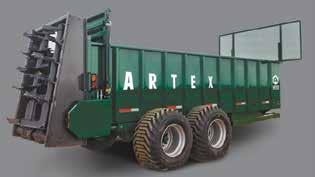


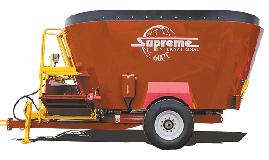


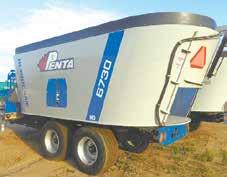
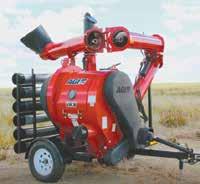







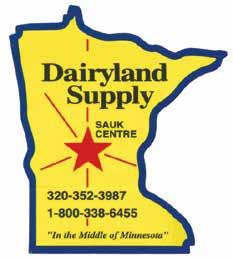


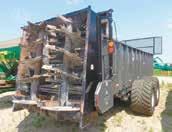
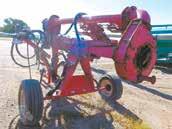



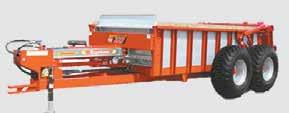




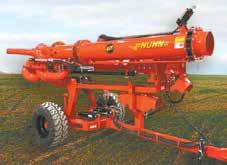


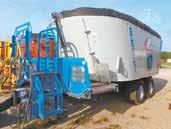

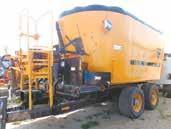

How many times a day do you milk, and what is your current herd average, butterfat and protein? We milk two times a day. Our butterfat averages 4.6% and our protein averages 3.5%. Our rolling herd average is 27,500 pounds of milk.
Describe your housing and milking facility. Our cows are housed half of the time in a stanchion barn and the other half in a freestall barn. We milk in a 38-stall stanchion barn, then switch our cows, bringing the cows in from the freestall barn.
Who is part of your farm team and what are their roles? Rick is in charge of most things that take place on the farm. Rick and Ann do all the milking. Ann takes care of the calves, both morning and night. During the day, she works at Jordan Public Schools. Ann also does all the bookwork for the farm. Tony, Ann’s brother, helps with morning chores, including cleaning and bedding the barns, feeding youngstock and grinding feed for steers and calves. Our three sons, Kevin, Jason and Jeff, help out as needed, especially when we are doing eld work or taking some time off. They all are married and have off-the-farm jobs. Our daughter, Emily,

lives out of state but helps with the milking and feeding whenever she is home. Our neighbor, Gene, lls in whenever he is needed for chores and eldwork.
What is your herd health program? We have a herd
exam every two weeks. We have been using the G6G breeding program for about 10 years and have had very good success with it. Twice a year, all the youngstock are vaccinated with a 9-way vaccine and a pour-on wormer. Newborn calves get two doses of
Nasalgen 3-PMH at 7 days old and again around 30-40 days old.
What does your dry cow transition program consist of? We dry our cows off 60 days before they are due. When drying them off, they
get milked once on the rst day, then skipped on the second day. On the third day, they are milked in the morning before receiving Quartermaster dry tubes and a sealant. They are vaccinated with Vira Shield and Endovac. We then put them with the bred heifers and other dry cows. Two weeks before freshening, they are brought into a close-up pen located in the corner of the barn. They are boosted again with Vira Shield and Endovac. We put them on a special dry cow feed consisting of dry hay, corn silage, ve pounds of ne ground corn and dry cow dietary cation-anion difference concentrate. After they freshen, they stay in the stanchion barn for two days before being switched in and out of the freestall barn with the rest of the herd.
What is the composition of your ration, and how has that changed in recent years? We feed a total mixed ration of corn silage, haylage, ne ground corn, a concentrate blend from Big Gain, cottonseed and EnerG-3. Over the years, we stopped feeding dry hay and coarse ground corn.
Turn

Has been a quality market for MN dairy farmers for over 100 years. MN producers provide one of the country’s most distinctive brands of cheese that is still made using the same Old World craftsmanship and has been combined with cutting-edge technology to produce cheese that delivers unforgettable taste with unparalleled quality. MN Dairy farmers and Bongards, quality that stands the test of time. We offer a competitive base price, premiums, and the best eld representatives in the industry.
13200 Co. Rd. 51
Bongards, MN 55368 (952) 466-5521
Fax (952) 466-5556
110 3rd Ave. NE
Perham, MN 56573 (218) 346-4680
Fax (218) 346-4684
“It

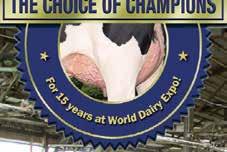
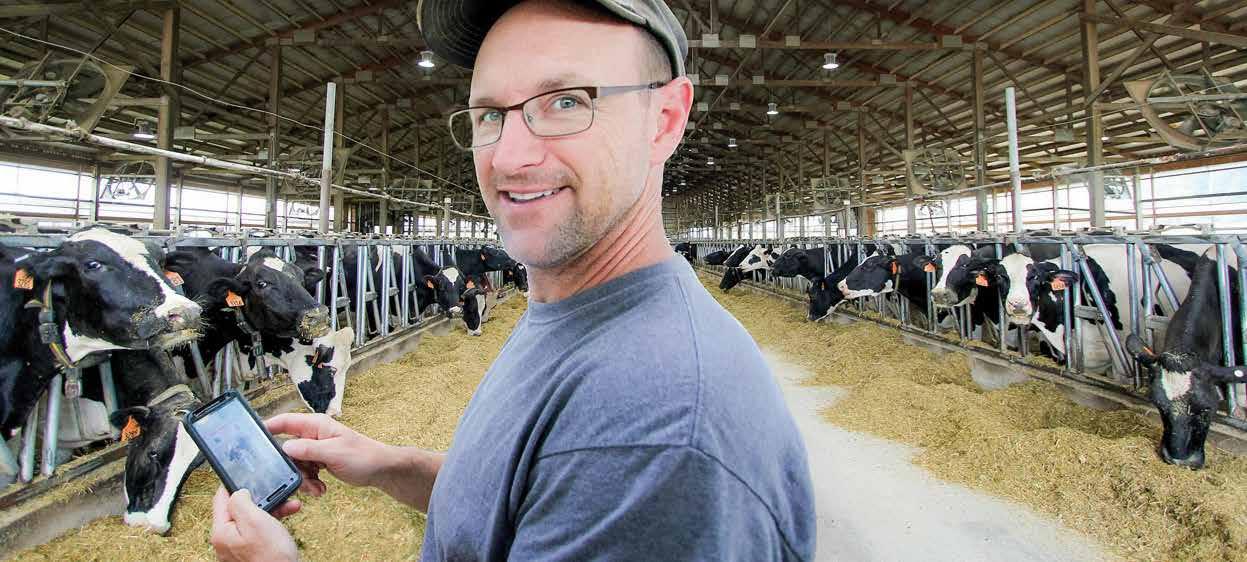
“We have consistently been using Udder Comfort™ for over 15 years. It fits our focus on comfort and quality. Our goal is high component, low SCC milk, shipping at least 8 pounds of solids and 120 pounds of energycorrected milk per cow,” says Mitch Breunig, Mystic Valley Dairy, Sauk City, Wisconsin, home of Jenny-Lou Holsteins.
Of the 455-cow milking herd with records to 55,000M, 118 completed records over 150,000 lifetime milk in 2024. This 12-time Holstein USA PBR herd, based on production, homebred percentage (93.9%), and conformation, has earned 24 Progressive Breeder Awards and is in the top 25 Holstein herds for fat and protein in the U.S.
“Cows that start clean tend to stay clean throughout their lactation,” says Mitch.
“We spray every fresh udder with Udder Comfort 2x/day for 3 to 7 days and see SCCs come down much faster. It gets fresh cows off to a great start on a quality lactation,” he explains.



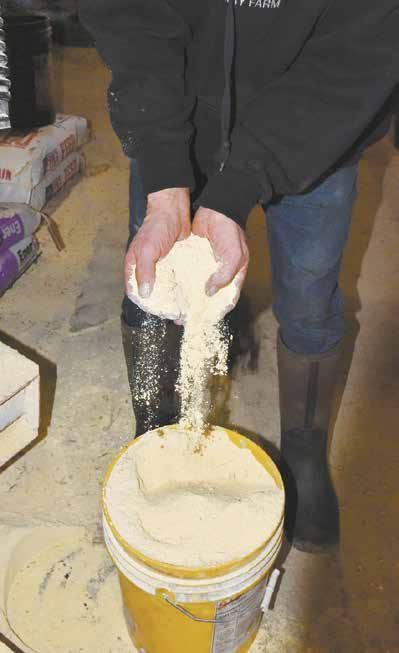
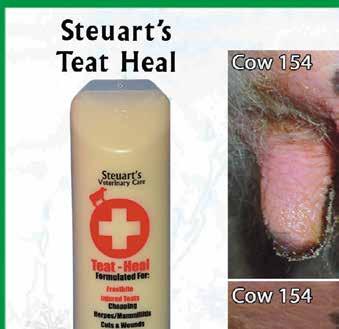

Tell us about the forages you plant and detail your harvest strategies. We plant all brown midrib corn for silage. The alfalfa is started in spring with a triticale and pea mixture. This is harvested for the heifers. We try to cut hay every 28-30 days. We like to cut it all at once. First and second cuttings are put in a silo and bag. Third and fourth cuttings are used to rell the silo. We big square the rest and use the bales to feed youngstock. The corn silage is stored in a pit silo, a stave silo and a bag. The bag is not opened until the next fall, in hopes we do not need to feed fresh silage until it has fermented for a few months.
What is your average SCC and how does it affect your production? Our somatic cell count averages about 120,000, although in the winter we can generally keep it under 100,000. In the summer it is a little tougher to keep it low. We use sand bedding in both the stanchion barn and the freestall barn. We think sand bedding and vaccinating with Endovac helps keep the SCC down.
What change has created the biggest improvement in your herd average? We work closely with our nutritionist, Frank, from Big Gain. We feed only high-quality feed, including ne ground corn and the BMR corn silage. Sand bedding, tunnel ventilation in the stanchion barn and more fans in the free stall barn have also
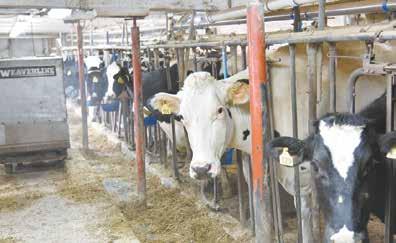
helped to increase the herd average. We also added a soaker line over the feed alley in the free stall barn to keep the cows cool in the summer.
What technology do you use to monitor your herd? We use the Dairy Herd Improvement Association report to monitor cows that have a high SCC and cows that are high in days in milk, but did not breed back. DHIA is also used to monitor low-producing cows. Using the two-week herd exam helps monitor open cows.
What is your breeding program and what role does genetics play in your production level? Everything is bred the rst time using the G6G program. We herd exam every two weeks. We use all high Net Merit bulls.
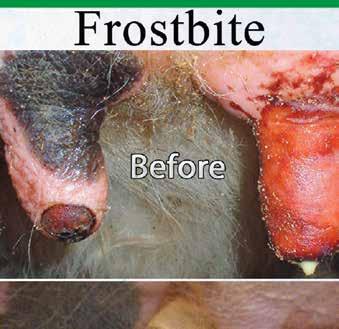
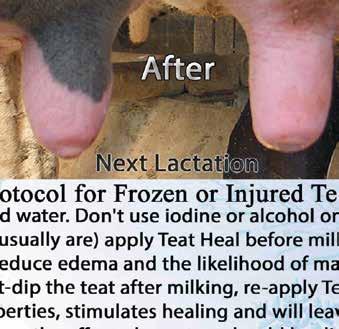
List three management strategies that have helped you attain your production and component level. Using BMR corn for silage, grinding the corn to 300 microns and feeding cottonseed have all played a role is helping us to reach our current levels of production and components.
Tell us about your farm and plans for the dairy in the next year. We live on a century farm where we plant 375 acres of corn, soybeans and alfalfa. We milk 85 cows and nish all of our steers. Our milk is shipped to Bongards. In the next year, we plan to continue striving for herd health and timely breeding to keep the farm protable.
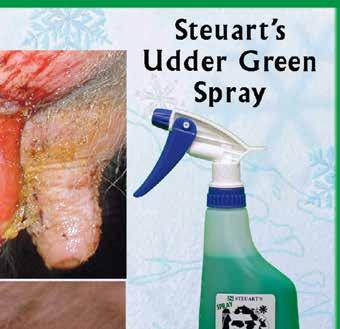






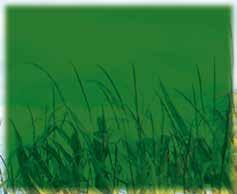





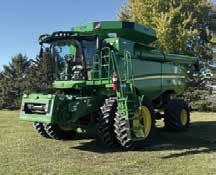




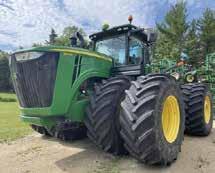








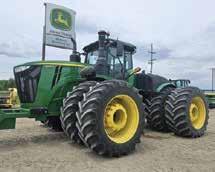



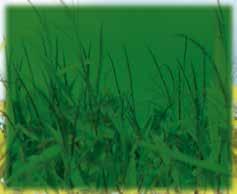









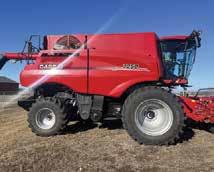












Contact one of the following dealers to learn more:
IOWA
Prairie Land Ag Supply Inc.
Rock Valley, IA 712-476-9290
United Dairy Systems, Inc. West Union, IA 563-422-5355
Monticello, IA 319-465-5931
WISCONSIN
Advanced Dairy Spring Valley, WI 715-772-3201
Bob’s Dairy Supply Dorchester, WI
715-654-5252
Ederer Dairy Supply Plain, WI
608-546-3713
DeLaval Dairy Service Kaukauna, WI 866-335-2825
Joe’s Refrigeration Inc. Withee, WI 715-229-2321
Mlsna Dairy Supply Inc. Cashton, WI 608-654-5106
Professional Dairy Services Arlington, WI 608-635-0268
Redeker Dairy Equipment Brandon, WI 920-346-5579
The Scharine Group Inc. Whitewater, WI 800 472-2880 Mt Horeb, WI 800-872-3470
MINNESOTA & SOUTH
DAKOTA Farm Systems
Melrose, MN
320-256-3276 Brookings, SD 800-636-5581
Advanced Dairy Mora, MN
320-679-1029 Pierz, MN
320-468-2494
St. Charles, MN 507-932-4288 Wadena, MN 218-632-5416













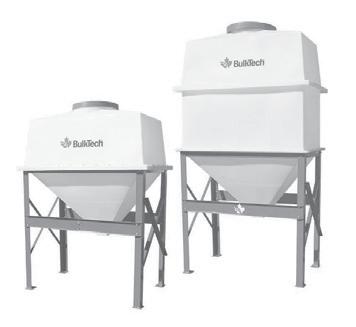


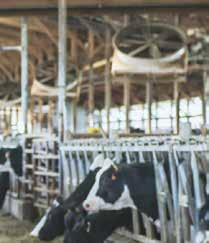


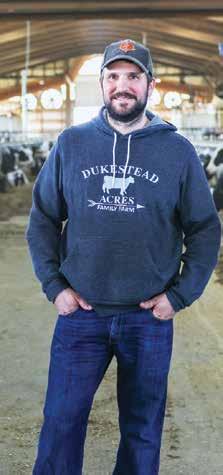


























By Emily Breth emily.b@star-pub.com
WAVERLY, Minn. — Garret and Amber Duske along with their kids — Emmit, Hazel, Colton and Charlotte — have focused on making their farm more efcient so they have more time to give back to the community and be with family.
“You could constantly stay busy for 16 hours a day seven days a week,” Garret Duske said. “I don’t see enjoyment in that. I didn’t get married and have kids to not be able to see them.”
The family’s hard work and dedication were recognized when they were named the 2024 Wright County Farm Family of the Year.
“I didn’t know there was such a thing until last year when a good friend of ours got it,” Duske said. “I thought it was cool and it was pretty neat and nice to get recognized.”
The family milks 94 cows in a tiestall barn. The farm
is operated with the help of Duske’s dad, Cliff, and his uncle, Keith. They also raise approximately 350-400 feeder cattle youngstock to around 400 pounds and grow 600 acres of crops.
The Duske farm has been in the family since the 1930s and Duske is the third generation to own the farm. Through the family’s long presence in the area, Duske has come to know many people, which amplies the importance of community to him.
Cliff and his wife, Wendy, made an impact on Duske’s life and are the reason Duske said he wants to help others as much as he can. Growing up, Duske watched nearly 70 kids, between his parents fostering and running a daycare, come through his childhood home over the years. He said this is where he learned to give back whenever he could.
“You see all these kids and what they come from, and if I can change a life by being in an organization, helping out at church or donating food to
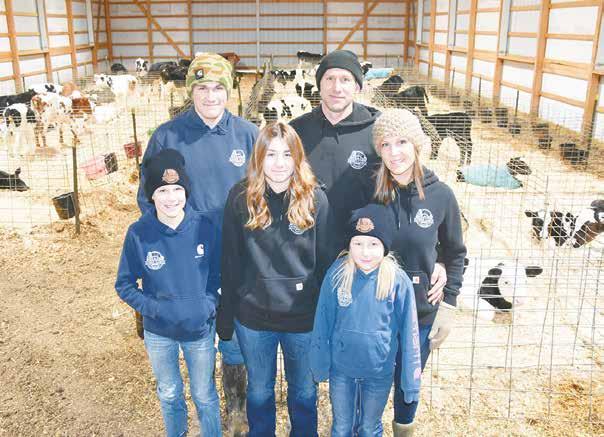
someone (I will),” Duske said. With time investments into the farm, the community and his family, Duske focuses on
Air King industrial air cleaners are a valuable tool for capturing most airborne nuisance particulate. Our self-contained filtration units continuously pull contaminated air through multiple stages of highly efficient micro-glass filters. The filtered air is then recirculated back into the working environment without the need for duct work. This results in a cleaner, healthier atmosphere for employees, while saving you money by keeping heated or air-conditioned air inside your facility.
balancing his time and knowing what can wait to get done on the farm.
“We made a big point over
the last 10 years of making it more efcient, as in, if something happened to (my dad)
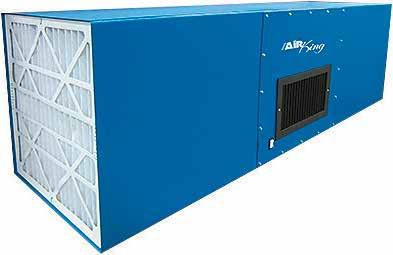



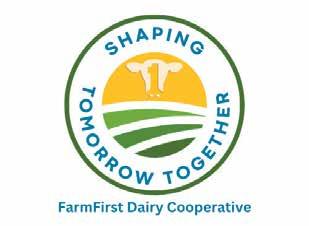

Join us at the Stoney Creek Hotel and Event Center on February 7-8th, 2025, for an event filled with intrigue and excitement, where we come together to shape a brighter future.
Friday, February 7th At 1:30 PM, uncover the hidden truths of the FARM program at the Producer Discovery Workshop with Beverly Hampton Phifer (NMPF Senior Director of Animal Care) and FarmFirst’s certified animal evaluators.
As night falls, anticipation builds for the arrival of a mysterious guest. Who is this master conjurer? What tricks do we have up our sleeves? Only those present will discover the truth.
Following the banquet, our annual live auction begins. The stakes are high, the treasures invaluable, and our efforts will help support our scholarship program.
Saturday, February 8th Our business meeting will determine the future as we shape tomorrow together. Kevin Beauchamp from Galloway Company in Neenah, WI keynote address will inspire you as you learn the role of dairy farmers and processors in our future.
MARK KLAPHAKE/DAIRY
(Right) Garret and his dad, Cliff Duske, stand together in their shop Dec. 31, 2024, at their farm near Waverly, Minnesota. Garret learned many life lessons from his parents, Cliff and Wendy, who fostered and provided daycare for around 70 kids.
Garret Duske cleans pens with a skid loader Dec. 31, 2024, at the Duske farm near Waverly, Minnesota. The Duske family milks 94 cows in a �estall barn.


or my uncle I could run the farm by myself,” Duske said. “It would be the spring or the fall when I need help.”
The Duskes have been members of Albion Evangelical Free Church for seven years. They used to teach a Sunday school class and now Amber helps with Awana on Wednesday nights, a class for kids from 3 years old through sixth grade. Through their church, the Duskes also donate food to be given to people in
need.
The family is involved in Howard Lake-WaverlyWinsted FFA Alumni. They also volunteer at a fundraising tractor pull, which was started by Duske’s nephew in 2019. The proceeds from the pull go to support agriculture education and the HLWW FFA chapter. It is held on Memorial Day weekend each year. Duske said many people who win donate the money back to the fundraiser.
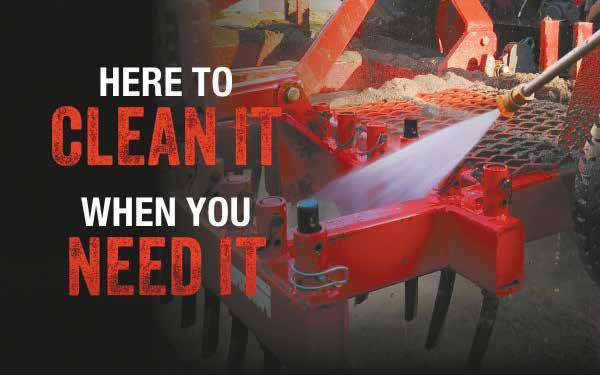
“2021 was our record year,” Duske said. “We have over 100 hooks every year. Attendance is full and we get a lot of people in the community to come and help and volunteer their time to run gates and sell tickets.”
Even when it comes to community involvement, Duske still aims to manage his time so he can be home at night.
“It’s been fun to do, (but) we don’t want to be up until 2 in the morning,” Duske said.
The Duskes’ kids are active in FFA, football, basketball, band and choir. Duske strives to be at as many games and concerts as possible.
“I try to be milking by 3 at night so I can go to my daughter’s games, I don’t want to miss them,” Duske said. “We just try to make (the farm) family friendly. I still want to be a family farm … so I have to expand with what I have here.”
There will always be work to do on a farm, Duske said, but he believes it is important to know when to take a break. He values being able to spend extra hours with his family or helping people in need.
“I enjoy helping other people out because I have been blessed with so much myself,” Duske said. “I wouldn’t have what I have if it wasn’t for God. I look at the world and people complain about what they don’t have. I look at it and say thanks for what I do have.”
Whether
By Amy Kyllo amy.k@star-pub.com
KELLOGG, Minn. —
For Garret and Alicia Miller, juggling dual roles is an everyday reality that brings both sacrice and reward.
At Garret’s full-time job, he spends mornings and afternoons across the Mississippi in Wisconsin working as a milk inspector for the Wisconsin Department of Agriculture, Trade and Consumer Protection. At his second job, he spends weekends and weekday early mornings and evenings working on his family’s dairy farm near Kellogg.
“It’s always been my lifestyle,” Garret said. “I’m not the type to sit around and let grass grow under my feet. … The reward (is) in the end, seeing the crops grow, harvesting the crops, and … raising the calves.”
Though Alicia is not involved on the dairy, she is part of making it all happen. She works as a special education








The Miller family — Garret holding Aida Jo (from le ) and Alicia holding Tucker — gathers Dec. 11, 2024, at the Miller family farm near Kellogg, Minnesota. Garret works on the farm with his parents, Dan and Karen, who milk about 90 cows.
teacher in Lake City and takes on extra childcare for their two children, Aida Jo and Tucker, so that Garret can farm.
On the farm, Garret works beside his parents as well as his siblings, Blaine and Ellie, who help occasionally around their full-time jobs, with Blaine doing most of the grain trucking. Garret’s youngest sister, Ava, works on the farm in the afternoons after school.
Spending time with family is Garret’s favorite part of dairy farming. This has been especially meaningful because of the sudden and unexpected death of his 16-year-old brother, Aidan, in 2019 from cardiac arrest. Being on the farm has been part of navigating life after loss the Millers said.
“Growing up and spending every day working alongside family is something that’s often taken for granted,” Garret said. “Thinking back on the short 16 years I had with Aidan, I spent more time with him in those 16 years than most people spend with their family in a lifetime. There are not many other occupations out there that you could say that about.”
“I know farming makes him happy,” Alicia said. “It takes a lot of time away from our family, but I know it’s something that (he gets to do).”
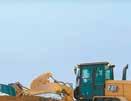












Garret’s parents, Dan and Karen, milk about 90 cows in an over 100-year-old, 44-stall, tiestall at parlor. Cows are housed in a sand-bedded freestall barn. They also raise feed and cash crops on 340
owned and rented acres.
Garret’s role on the dairy includes milking and chores, hauling manure, eldwork and more.
“I’ve been basically involved in the dairy ever since I was born,” he said.
Garret has been working in Wisconsin for about eight years, but his rst job as a milk inspector was working for the Minnesota Department of Agriculture in the St. Cloud area.
Garret said working as a milk inspector allows him to gain new ideas for the dairy.

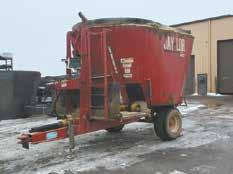
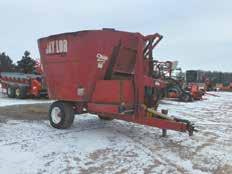


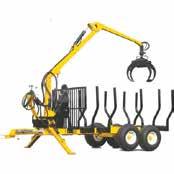
AMY KYLLO/DAIRY STAR
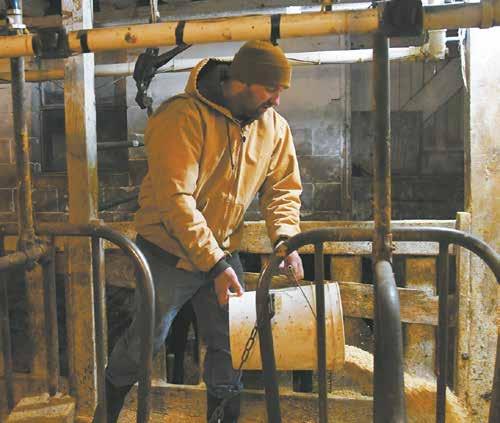
“Every day I’m seeing different setups and some of the best ways of doing things for other people,” he said. “It’s always good to bring those ideas back home and incorporate them into our facility to make it better.”
Garret inspects around 400-500 dairy farms on the western side of Wisconsin. Some counties in his coverage area include Trempealeau, Buffalo, Pepin, Pierce, St. Croix and Dunn. He said a big reason he took the job is the opportunity to see the countryside.
“It’s probably one of the coolest areas around with the bluffs … and the river and all that,” he said. “I inspect everything from the 10-cow herds to 7,000-cow dairies. Getting to see the variety and the countryside, I guess is what I enjoy most.”
Garret said it was an adjustment to be in a role where those he interacts with are not always looking forward to his presence because of his authority.
“Once people get to know you and know your background a little bit, I think that helps the relationship and people understand that we have a job to do and it’s part of the position,” he said.
Garret said being a dairy farmer himself helps with this.
“When I’m going out and … enforcing the rules and stuff, it helps to have a background in the dairy industry, (versus) somebody with no background, coming out and telling them, ‘You have
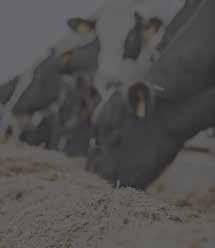
• Multi Species Consulting • Custom Rations and Feed Testing • Commodity Contracting
• House and Name Brand Feeds
• Calf Feeds, Milk Replacers, and Housing
• Show Feeds and Supplies
• Covers, Wrap, Bags, Inoculant, and Twine

Garret Miller prepares grain for evening milking Dec. 11, 2024, at the Miller family farm near Kellogg, Minnesota. Besides helping his parents farm, Miller works full me as a milk inspector in Wisconsin.



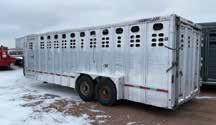
to do it this way,’” he said.
Alicia said there have been family sacrices made so that Garret can work on the dairy farm. Alicia played volleyball in college and was approached for coaching positions in Lake City. However, because Garret is at the farm in the evenings when she would need to be at practices and games, she forwent the opportunity to support Garret’s farming passion.
“You have to give up things,” Alicia said. “It’s worth it because, obviously, this is important to him. … Sometimes you have to give a little more when it’s farming related. I have to take care of the kids more, and he’s got to be up here (at the farm).”
For Garret one of the biggest rewards of the farm is introducing it to their children. He enjoys having them help with chores and showing them the calves.
“It’s important to learn hard work at a young age, and better to be outside and around the animals rather than sitting on the couch and watching TV,” he said.
Garret plans to continue be a milk inspector, but he does not know the future of his family’s dairy when his parents retire someday. He said he may potentially take over the dairy, however, their facilities are small and aging.
“I’ll always be involved in the farm some way or another,” Garret said. “If it’s not dairy, it’ll denitely be beef. … There will always be cattle on the farm.”
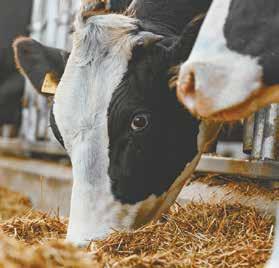
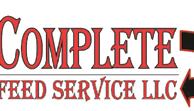





















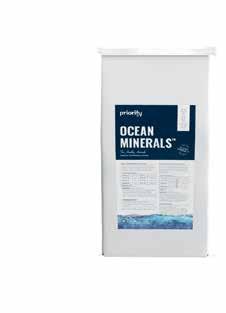

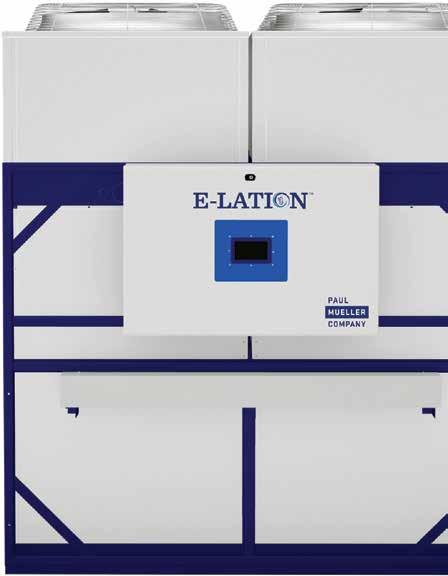

Advanced Dairy Spring Valley, WI; Mondovi, WI; West Salem, WI; Mora, MN; Pierz, MN; Wadena, MN; St Charles, MN
Central Ag Supply Juneau, WI; Baraboo, WI
Eastern Iowa Dairy Systems Epworth, IA
Ederer Dairy Supply Plain, WI
Fuller’s Milker Center Lancaster, WI; Richland Center, WI
Gorter’s Clay & Dairy Equipment Pipestone, MN
J. Gile Dairy Equipment, Inc. Cuba City, WI
Leedstone Melrose, MN; Glencoe, MN; Plainview, MN; Menomonie, WI
Lely Center Monroe Monroe, WI
Midwest Livestock Systems Zumbrota, MN; Renner, SD; Menomonie, WI; Kaukauna, WI; Weston, WI
Monroe Westfalia Surge Monroe, WI
Professional Dairy Services Arlington, WI
Redeker Dairy Equipment Brandon, WI
Sioux Dairy Equipment Rock Valley, IA; Colton, SD
Stanley Schmitz Inc. Chilton, WI
Total Dairy Service Kewaunee, WI
Tri-County Dairy Supply Janesville, WI
United Dairy Systems West Union, IA; Monticello, IA




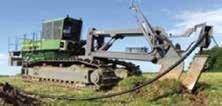
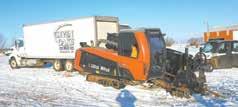




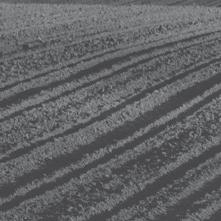








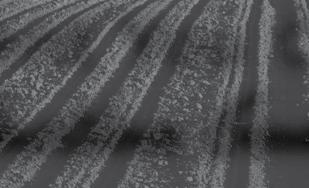










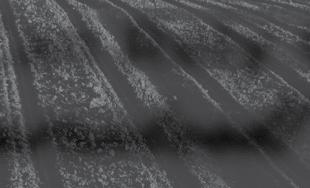
















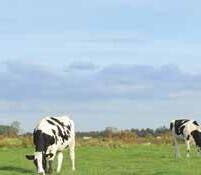














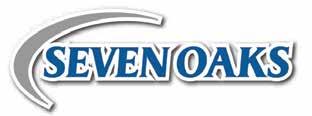




Modern farming is rapidly evolving with the integration of advanced technology, and calf care is no exception. Recently, I saw some new things that may help improve calf health and well-being that might be something that we have never thought of. I go in-depth on many of these technologies in The Moos Room podcast episode 270. But, I will describe these briey and give an example about some calves I put sensors on after World Dairy Expo. In the future, we will explore how sensors are transforming calf management by providing early health insights, improving productivity and potentially saving farmers time and money.

By Brad Heins University of Minnesota
Activity monitoring sensors have been used for many years for breeding management. Farmers also use them to detect health issues in dairy cows, mainly fresh cows. Wearable sensors for animals have improved agricultural conditions and farm management by aiding farmers in early disease detection and preventive health measures. Sensors have gained popularity for tracking calf behavior, health and overall performance. With the ability to detect early signs of illness, these tools offer a proactive approach to calf care and may ensure better growth rates, faster pregnancies and higher milk production later in life.

We have several sensor systems that we have tested on our dairy in Morris. Previously, we used pedometers for calves. These devices measure calf activity and steps but require frequent manual data downloads, making them less practical for daily farm use. Ear tags for calves have gained popularity in the last couple of months with some companies promoting these as lifetime monitoring of calves. You can put these tags in calves when they are born or just a few days old. Modern sensors integrated into ear tags monitor feeding and lying behaviors. They use farm-specic algorithms to provide alerts when calves deviate from normal patterns. There are also internal boluses that can be put into calves as well. These boluses track internal temperature and activity, offering precise insights into calf health. We have not used these in our calves. All these sensors can be paired with mobile apps for monitoring growth, health treatments and performance metrics.
The West Central Research and Outreach Center dairy in Morris has had CowManager ear tags since 2013. So, after learning about lifetime calf monitoring, I decided to take some action. I was curious if these would work, how they would work, if we could make any sense out of the data, and how this in-

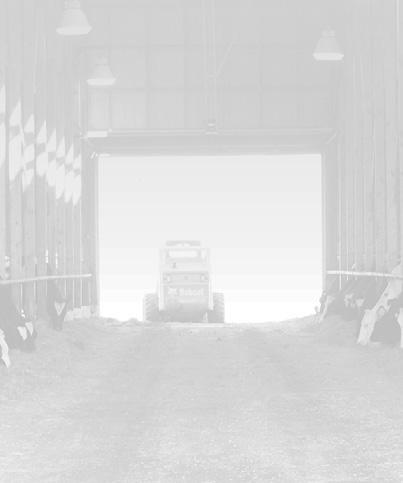



formation would correlate to behavior of these calves on an automatic calf feeder. I was also curious about rumination in pre-weaned calves.
We put them in 30 calves that were born during the fall 2024 calving season in Morris. We found them particularly useful for identifying health issues before visual symptoms appeared. For instance, a sick calf with scours showed decreased activity and rumination levels days before its condition worsened. This early detection allowed timely intervention, reducing potential losses. Data analysis revealed moderate correlations between rumination, activity and drinking speed from our automatic calf feeder. Calves with lower activity levels typically consumed less milk and showed signs of illness earlier than detected by traditional methods. This highlights the potential of sensors to complement automatic feeders in identifying at-risk animals.
From the gure of a particular preweaned calf in Morris across a 60-day period, you will notice many things. It shows that the calf is ruminating at a few days old. Is this really rumination, probably not? It might be drinking behavior of calves combined with eating behavior. At about 3-4 weeks of age, rumination and eating behavior really in-
creased, and the activity level increased, which we would expect as calves are getting older. We are going to watch these calves as they are weaned to see what happens to all these behaviors.
While the benets of sensors are clear, their cost can be a barrier. The sensors for calves may cost from $100$160 per calf. This can lead farmers to carefully evaluate whether the savings from early illness detection outweigh the initial investment. Farms already using automatic feeders may nd sensors a useful supplement rather than a replacement for monitoring systems.
Sensor technology is poised to play an even bigger role in calf management as farmers strive for more data-driven approaches to improve efciency and animal welfare. We plan to continue testing sensors in our dairy herd. While sensors provide promising tools for monitoring calf health, they are not a substitute for hands-on observation and care. Farmers must weigh the costs and benets to determine if these technologies t their operations. As adoption grows, future advancements may lower costs and improve integration with existing systems, making sensors a more accessible tool for farms of all sizes. For more insights, visit The Moos Room podcast.
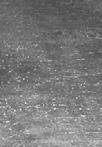
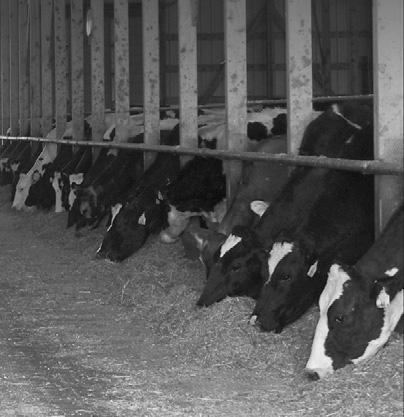
Dana Adams adam1744@umn.edu 320-204-2968
Luciano Caixeta lcaixeta@umn.edu 612-625-3130
Gerard Cramer gcramer@umn.edu 612-625-8184
Marcia Endres miendres@umn.edu 612-624-5391
Brad Heins hein0106@umn.edu 320-589-1711
Nathan Hulinsky huli0013@umn.edu 320-203-6104
Karen Johnson ande9495@umn.edu 320-484-4334
Emily Krekelberg krek0033@umn.edu 507-280-2863
Claire LaCanne lacanne@umn.edu 507-332-6109
Brenda Miller nels4220@umn.edu 320-732-4435
Isaac Salfer ijsalfer@umn.edu 320-296-1357
Jim Salfer salfe001@umn.edu 320-203-6093
Mike Schutz mschutz@umn.edu 612-624-1205
Melissa Wilson mlw@umn.edu 612-625-4276
Isaac Haagen hagge041@umn.edu 612-624-7455
Michael Boland boland@umn.edu 612-625-3013
Sabrina Florentino slpore@umn.edu 507-441-1765
Scott Wells wells023@umn.edu 612-625-8166
Erin Cortus ecortus@umn.edu 612-625-8288
Melissa Runck mkrunck@umn.edu 507-836-1143




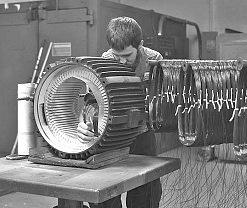
Raising calves in cold climates requires careful attention to health, environment and nutrition to ensure proper growth and development. Below are strategies to help calves thrive during winter and reach their genetic potential by doubling their birth weight by 56 days of age and achieving 55% of mature body weight at breeding.
Understanding calf temperature regulation
A newborn calf’s thermal neutral zone is between 6077 degrees, the range where they require minimal energy to maintain body temperature.
When environmental temperatures are below the thermal neutral zone, the calf uses energy just to maintain its body temperature. Even on a warm winter day of 40 degrees, the maintenance requirement for calves younger than 3 weeks old is 40% higher than when temperatures are within the thermal neutral zone. At zero, the maintenance requirement is about double. Additional measures must be taken during the winter to help calves reach growth targets and remain healthy.
Get calves off to a good start
The calving area should also be draft free. Dry calves immediately and ensure the calving area is draft free. Use warming boxes or heated rooms if calving occurs in cold conditions. Warm chilled calves promptly to prevent hypothermia.
Calves are born with only 3%-4% body fat. They are also born with a special layer of fat called brown fat. Brown fat’s only purpose is to release energy as heat. Rapid drying helps conserve these reserves.

By Jim Salfer University of Minnesota
The rst day of a calf’s life is critical for long-term health, especially in winter. Follow these key practices.
Provide high-quality, clean colostrum within a few hours of birth. A gallon of colostrum containing 50 grams of immunoglobulins per liter (22% on the Brix scale) is essential to provide nutrients for immunity and energy. Colostrum below 20 grams per liter of IgG should not be used unless supplemented with a colostrum supplement or replacer.
Wet calves lose body heat rapidly.


Increase nutrition
In cold weather, calves need more energy. This is especially important before consuming starter feed. Once consuming starter and ruminating, the heat produced by feed digestion helps keep calves warm. Offer eight or more quarts of high-quality milk replacer or whole milk per day. Research shows this supports growth without causing scours. Increase feeding frequency to three times daily or provide larger amounts per feeding. Avoid over-concentrating milk replacer powder, which can cause dehydration, especially if water access is limited. Feed milk at 105 degrees to ensure calves don’t expend energy warming it internally. Adjust the initial temperature in cold weather to achieve a milk-feeding temperature of 105 degrees. Offer warm water to stimulate grain consumption and rumen development. Remove water from buckets after 10 minutes to prevent freezing.
Encourage early starter feed consumption. Rumination generates body heat, helping calves stay warm.
Calf blankets
Blankets signicantly improve insulation. Canadian research showed a 52%
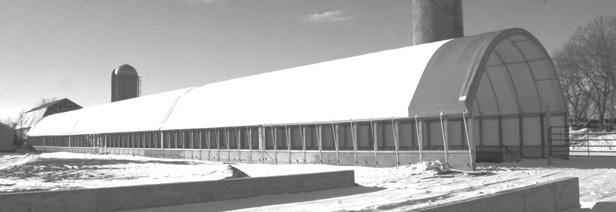


increase in insulation for calves housed at temperatures between zero and -22 degrees.
Clean, dry bedding
Use lots of clean, dry straw for bedding. Calves’ hair coats provide excellent insulation if they are clean and dry. Damp bedding reduces insulation. Test by kneeling; if your knee gets wet, so will the calf. Bed calves to a nesting score of three, where the calf can nestle deeply into the bedding material and its legs are not visible.
Ventilation
Ensure fresh air circulation to reduce humidity and pathogens while avoiding drafts. Most hutches have openings or vents to keep air fresh for the calves.
Ventilating calf barns can be a challenge. Inadequate ventilation means higher humidity, noxious gases and bac-
terial growth, resulting in more diseases. A calf’s environment needs to remain draft-free but there must be a way for fresh air to circulate. Pay particular attention to the microenvironments within the resting areas.
Delay weaning
Weaning is a stressful period. Consider delaying it during extreme cold. Typically, Holstein calves can be weaned when consuming three pounds of starter for three consecutive days. However, postponing weaning helps calves better cope with the stress of cold weather.
Raising calves in winter requires heightened attention to nutrition, housing and environmental management. By following these strategies, producers can ensure healthy, vigorous calves that thrive in cold climates, meeting growth benchmarks and developing into robust replacements for the herd.
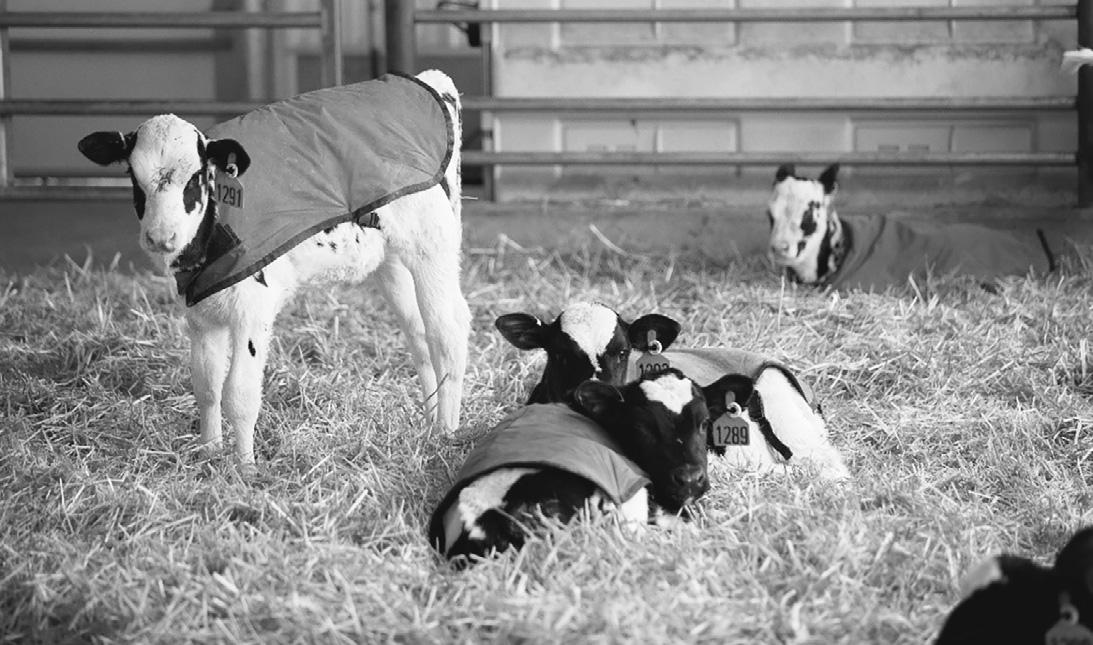

CIH 7240 FWA 3,400 hrs. - $95,000
USED TRACTORS
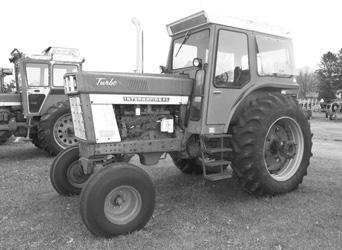
IH 1466 w/cab, 3854 orig. hrs. Coming In
CIH 8910, 1955 hrs., 2WD, like new .....$105,000
CIH 7120, 2WD, 5800 hrs. ......................$55,000
CIH 5250 2WD, 4,700 hrs. ......................$54,000
CIH MX120, 2WD, 3,800 hrs. ..................$72,000
CIH MX120 w/loader ...............................$75,000
IH 1456, cab ............................................$22,000
IH 1466, 6800 one-owner hrs ..................$21,000
IH 1256 ....................................................$14,000
IH 686 ......................................................$14,000
‘98 JD 7610, 19 spd., PS, 5,500 hrs., 25 MPH, very sharp ..............................................$75,000
McCormick MC120 FWA, 2,600 hrs. .......$57,000
TILLAGE
CIH Tigermate II, 26’ ...............................$28,000
CIH Tigermate II 26’ w/rolling basket.......$32,000
CIH Tigermate 200 w/basket, 34’ ............$42,500
CIH Tigermate 200, 28’ w/rolling basket ...$40,000
CIH Tigermate 200 28’ w/basket .............$37,000
Tigermate 200 28’ w/rolling basket ..........$31,000
DMI Tigermate II, 26.5’, 3-bar mulcher ....$14,000
CIH RMX 370, 23’, nice ...........................$32,000
CIH RMX 340, 28’ w/mulcher ..................$35,000
CIH 530C Ripper, nice.............................$31,000
DMI 2500 5-shank ripper ...........................$9,900
DMI 500 5-shank ripper .............................$8,500
CIH 870 9-shank ripper ........................Coming In
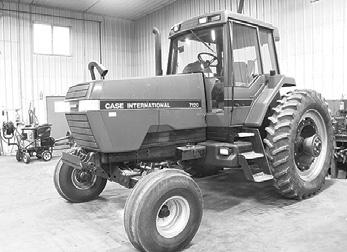
How did you get into farming? My wife, Sheila, and I bought the farm from my dad, Alvin, back in 1980. I grew up on this farm, and it has been in the family for more than 100 years. I am the third generation to be on the farm.
What are the most signicant ways your farm has changed since you started farming? Improvements in milk production and getting some new and better equipment have been some of the biggest changes I made. I also built a loang barn in 1992 for the heifers.
What was a challenge you faced in your dairy farming career and how did you overcome it? One challenge has been nding parts for my milking equipment since it is all original from when I started milking. I had a high somatic cell count at times and I worked with vets and people from Sunrise Ag Coop. I just had to work it through with other people.
What is the best decision you have made on your farm? Buying the skid loader back around 1992. When I rst had my heifer barn up, I just had a tractor and loader to do work in there and that was a pain, so I got a skid loader and that was way better. It’s made picking rocks and handling the heavy things a lot easier. That skid loader gets used a lot.
What three things on the farm can you not live without? A cab skid
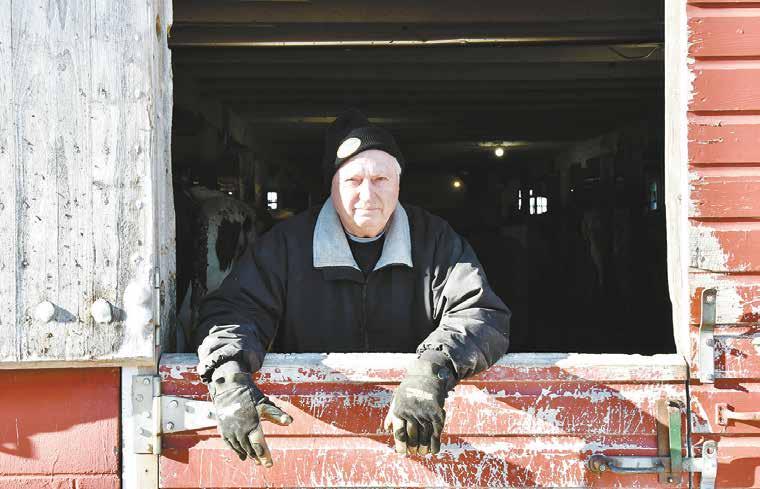
loader; I feed and bed with it and it is a lot warmer than my rst two skid loaders. Another is the other machinery I bought over the years that helps me get my work done in a reasonable time.
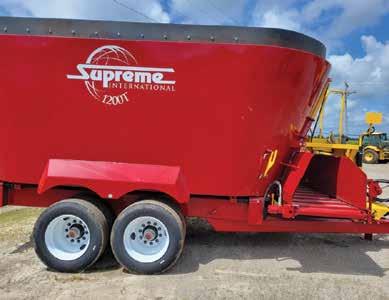

What are your thoughts and concerns about the dairy industry for the next year? I’m skeptical about what the price is going to do because it was coming up, but now it has gone
down again. It makes a big difference fast since I’m a small farm.


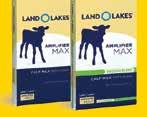














What strategies do you use to withstand the volatile milk prices? At my age, I just do not buy anything anymore. I just try to limp it through and do what I can with what is already here.
How do you retain a good working relationship with your employee(s)? Or, how do you maintain family relationships while also working together? I prioritize my family over the farm. I do take off a lot for family functions. The work will be there when I get back.
What do you nd most rewarding about dairy farming? The fact that you can take off when you want to. I also like being able to work from home and not having to drive to work. I enjoy being able to walk to work and having the time I want.
Tell us something special about your farm. The fact that the farm is 100 years old I would say is the most special thing to me. It is a good thing to have.
What are your plans for your dairy in the next year and ve years? I’m different because we just do stuff on the y, unlike bigger farms that do everything by the book. You cannot have fun with that. I have nothing major planned; I am just riding it out. I have no plans but to just quit when the time comes. I plan to play it by ear, whether milk prices get really low or something major breaks down.
How do you or your family like to spend time when you are not doing chores? We enjoy playing cards and seeing some of our friends. If you have the right crew, it can be really enjoyable. You have to be able to laugh things off.



Three, two, one. Like the countdown on Dec. 31 each year, people count down the days until they say, “New year, new me.” Growing up, my family never did anything big for the New Year, so I did not understand what the hype was all about.
Our New Year tradition was simple: sitting at home drinking sparking grape juice and taking turns falling asleep until midnight. After we counted down from 10, watched the ball drop and let out a little cheer, the TV would go black. We would then race to bed because we still had to wake up in the morning to do chores.
I have never been the type for New Year’s resolutions. The years I did make them I fell in line with the 80% or so who fail by February. Making a change to my daily routine or breaking a habit, whether it was a resolution or not, was never my strong suit.
Honestly, I think there is no perfect time to make a change in your life. If there is something to aim for or a goal to try and achieve, the perfect time is now. Most of the time, it is a matter of trial and error.
Dairy farmers know this better than anyone. Any given day can begin like every other: ordinary and according to schedule. However, it can quickly
turn into a race to get the cattle back in their pens, x a fence, repair water lines or drive an all-terrain vehicle loaded with tools to the eld.
Change is inevitable. It is going to happen whether you plan for it or if Mother Nature takes care of that for you. Growing up on the farm, I learned it is a lot easier to hop on and ride it out than to try to stop change from happening.
There have been many times when I found change to be unenjoyable and hard to get through. But with my many late-night talks with my mom, I became a strong believer in a quote made by John Mayer, “Someday, everything will make perfect sense. So, for now, laugh at the confusion, smile through the tears, be strong and keep reminding yourself that everything happens for a reason.”
cause I like trying new things and getting to meet new people along the way. I have made some great acquittances and owe it all to taking a risk on change.

By Emily Breth Staff Writer
For some, change is awkward and uncomfortable. I have found my attitude towards it largely dictates how smoothly it goes. Thankfully, I have had my mom, who never once failed to be there when I needed her.
I honestly enjoy change most of the time be-
Change can be a positive thing. Through time, perseverance or determination there will always be a light at the end of the tunnel. It may be dim, but it is there and there is only one way to nd out what is on the other side.
Life is a game of chance. Yes people can make choices, but they can only control so much. They cannot control what others do or how Mother Nature acts and there are no do-overs. One thing we can do is work toward preparing ourselves for change and becoming the best versions of ourselves.
So, while change is difcult and unenjoyable at times, it is important to remember to nd that light at the end of the tunnel. Trust what is given to you, believe in the work you put in and discover what is new. Discover what is out there, take a risk and nd the beauty in something new.




















Happy New Year.
This past year was one of gratitude, new beginnings and embracing challenges.
Reecting on the past 12 months, it is truly remarkable how much can happen in just one year. From completing my rst year of college, getting my rst internship, walking out of the show ring for the last time as a 4-H member, and achieving lifelong dreams, I am beyond grateful for the memories, friendships and accomplishments I carry with me into this new year.

By Rachel Visser
In just ve short months, my time as Princess Kay has already been a whirlwind of excitement, accomplishments, and learning experiences.
From being crowned at the Minnesota State Fair and having my likeness sculpted in butter to visiting schools and attending events, every moment has been unforgettable. While the Minnesota winter got in the way of attending a couple of events in December, I managed to beat the snow for an elementary school visit that left a lasting impression.
On Dec. 19, I visited three kindergarten classes at Royal Oaks Elementary School in Woodbury, Minnesota. All three of these classes have been participating in the Adopt A Cow program through Discover Dairy and have a picture of their calf taped on the classroom wall. Many of the students had never been on a farm before, but their eagerness to learn was contagious. Through reading a story, going on a virtual farm tour and sharing photos from the farm where I work, the students discovered how cows are cared for and how milk travels from the farm to the store. Seeing their faces light up as they eagerly asked questions was one of the most rewarding moments of the day. Equally as memorable, was leaving there knowing that I learned something from each of them.
Throughout high school, I spent summers babysitting and always admired the curiosity and innocence that kids possess. As I grow older, I continue to discover how much we can learn from their perspective. Leaving my visit with the kindergarten classes, I reected on how these students approached the day with no fear of being wrong. They condently asked questions, embraced new information and displayed an unltered enthusiasm for learning.
As we step into the new year, I think we can all take inspiration from these 5- and 6-year-olds. Whether it’s approaching new experiences with an open mind, looking at each day as another opportunity to learn, or asking questions without the fear of judgment holding us back, we can all benet from embracing the curiosity within us. Looking ahead to the rest of 2025, I’m especially excited for more school visits and the questions that students have about where their food comes from and how farmers care for their animals. I cannot wait to continue sharing the story of Minnesota’s dairy community and the passion I have for being a part of it. It is with this goal and passion in mind that I have made my goals for this new year. Sometimes, New Year’s resolutions can feel overwhelming, but this year, I’m keeping it simple: to nd joy in everything I do and learn something new from every experience. Whether at a Princess Kay event or not, I will strive to learn from those around me and soak
up every moment. I remain endlessly grateful to all of you, Minnesota’s dairy farmers, who make this incredible opportunity possible.
As I travel across the state as Princess Kay in 2025, I will continue seeking joy, learning from every experience, and sharing the dedication of our dairy community with everyone I meet. Together, let’s make this year one of curiosity, gratitude and growth. My calendar is continuing to ll up for school visits this spring and June dairy month appearances. Here is the link to submit Princess Kay requests throughout the year: https://www.midwestdairy.com/young-dairyleaders/dairy-princesses/request-a-visit-by-a-
dairy-princess/. Princess Kay of the Milky Way, Rachel Visser, serves as the Minnesota dairy community’s goodwill ambassador. Rachel grew up in Hutchinson, Minnesota working on a neighboring dairy farm. She attends the University of Minnesota double majoring in Agricultural Food and Business Management and Agricultural Communications and Marketing. Her favorite dairy food is cheese sticks. Her parents are Barry and Shannon Visser. Princess Kay is very active doing school visits and events representing dairy farmers, and sharing the importance of dairy farming and dairy foods at appearances across Minnesota.



The NxGEN offering provides elite, charttopping sires with diverse pedigrees and well-balanced profiles to maximize your herd’s genetic gain. Contact your local SSMC rep to add these breed-leading sires to your program!

















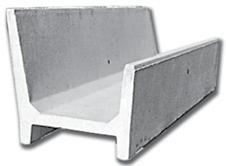
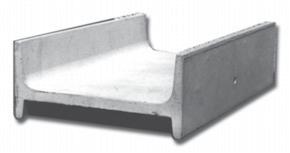
Every boy dreams of discovering buried treasure. Finding gold doubloons and muttering “Yar” are among its chief benets.
I recently voyaged out to where the rotting hulk has rested for the past 60 years. It was shocking to see how much she had deteriorated. The unsightly sags were even saggier; the overall impression was of accelerating decline.
Yep, Charlie’s old house isn’t much longer for this world.
My great-grandfather, Charlie, built the house that now molders out in my grove. Grandpa Nelson bought this farm from his father-in-law, so that house is where Dad and his siblings grew up.

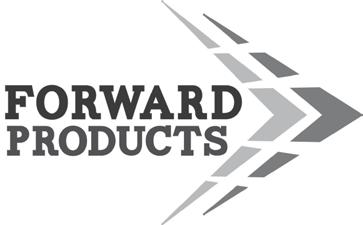
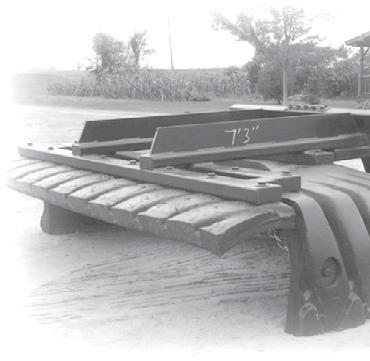


rapidly increased up the income scale using a formula similar to that for calculating terminal velocity. Should you land in the top tax bracket — $200,000 or more of annual income — you would owe $139,140 in taxes – plus 82% of everything in excess of $200,000.



By Jerry Nelson Columnist
It’s hard to believe that nine people lived in such a tiny space. Nowadays, that same number of square feet wouldn’t qualify as a walkin closet.
Entering Charlie’s old house is risky. The elements have ravaged her; what was once a kitchen is now a heap of decayed lumber.
Braving the obvious dangers, I clambered upstairs. Squatters have left their calling cards in the form of coon doots.
I sifted through the detritus Grandpa and Grandma left behind. I nd this endlessly fascinating, as if I’m an archaeologist reconstructing long-ago lives, lives that eventually gave rise to me.
I guess Congress gured that with a World War raging, no one should prot unduly from such a dire national emergency. Wonder how that would wash with the modern Wall Streeters who habitually award themselves multi-million-dollar bonuses?
It seems that Grandpa had little to fear from the uppermost tax brackets. A 1950 farm record book — compliments of Sioux Falls Rendering Company — contains such staggering earnings as “black mare, $25” and “sold eggs, $166.94.”
Other income streams include hogs and cattle and grain. Some quick mental math comes up with a total of about $3,000. Much of this was offset by expenses, the biggest of which was a mysteriously large entry for $109 listed under the “trucking, freight, welding, blacksmithing” column.
Making lots of money was never among Grandpa and Grandma’s top priorities. But this was before farming came to be known as agribusiness.











A canceled check from May 1952 establishes that Grandpa and Grandma’s electric bill was $4.08. The fact that this same sum was paid month after month indicates that their usage was below the minimum.
A yellowed envelope held a First National Bank promissory note Grandpa signed. Dated March 1925, it’s a loan for $150, quite a wad at that time. It took a while, but I was nally able to discern the “paid in full” stamp. I hate to think how much interest I would owe after a century.
A small envelope held a “just thinking of you” card that Grandma bought but never sent. In the corner of a bedroom was one of Grandma’s Sunday hats, tattered from raccoon roughhousing. A lone high-heeled shoe sat atop a jumble of Christmas cards that Grandma had received over the years.
An uncle’s fth-grade geography test was interesting in that he was able to correctly identify which countries the Danube and Rhone rivers traversed. I don’t think I ever knew that. Grandma had written some names on the back of a 1959 church bulletin. Each is listed as “Mr. and Mrs. --- and family” and constitutes a virtual roll call of my aunts and uncles. She probably made this list so she could quickly recall who her Sunday visitors had been when our local news lady called Grandma to ask if she had anything to report.










A tattered newsletter from Batcheller’s Feeds is dated June 1950. The front page gives advice about controlling corn borers with DDT and gushes about Niatox, a new and improved formulation of that particular pesticide. The ipside of the newsletter features recipes for homemade goodies from area farmwives.
Another envelope yielded evidence that the “good old days” weren’t all that good. The document is from 1943 and is titled, “Instructions for Form 1040, United States Individual Income and Victory Tax Return”. Its language is as dense as anything excreted by any modern bureaucrat.
The tax tables are quite educational. If you made $2,000 or less, you were taxed at the rate of 13%. Tax rates
Going strictly by the numbers, a reconstruction would paint a picture that was harsh and austere. But dig beneath the surface — and have access to insider information — and you’ll uncover lives that contained a treasure trove of family and friends.
Jerry Nelson is a recovering dairy farmer from Volga, South Dakota. He and his wife, Julie, have two sons and live on the farm where Jerry’s greatgrandfather homesteaded over 110 years ago. Feel free to email him at jerry.n@dairystar.com.



Right, wrong or otherwise, highly pathogenic avian inuenza H5N1 remains a hot topic in the production animal industries. After detection in dairy cattle across multiple states in March 2024, the U.S. Department of Agriculture implemented a series of testing requirements to document virus movement and prevent further spread. Fast forward to today, as new testing is being rolled out to monitor the status of HPAI in each state, new infections continue to be found in poultry, wild birds and dairy cattle.
Veterinary Wisdom

By Megan Weisenbeck Veterinary Wisdom
Currently, the federal order from the USDA mandates that all lactating dairy cattle crossing state lines have a negative inuenza test (milk sample) within seven days of movement. The number of animals tested depends on the number of cattle moving. Usually, if the group is larger than 30 head, then only 30 head need to be tested. If the group is smaller than 30 head, every cow in the load needs to be tested. A common example of this in our practice is farms selling lactating cows at outof-state auctions, both live and online. Note, however, that cull cows going to slaughter are typically subject to a different set of rules and paperwork depending on the state but do not normally need an inuenza test as long as they move straight to the packer. Non-lactating dairy cattle (heifers, dry cows, bull calves) are not currently required to have testing before interstate movement.
Another testing option for moving lactating cows includes the Dairy Herd Status Program. This program is for dairy producers who choose to enroll their herds and agree to weekly herd testing of bulk tank milk. To enroll in this program, the dairy producer must submit an application detailing the farm’s protocol for collecting and testing bulk tank milk along with other pertinent farm data. Once approved by the state vet and the USDA vets (in my experience in Minnesota anyway), the herd will then be eligible to submit bulk tank samples for inuenza testing. After three consecutive weeks of negative test results for HPAI, the herd will receive a “monitored unaffected herd” status. Continued weekly bulk tank
sample testing with negative results and participation in the status program allows the herd to maintain the “monitored unaffected herd” status and move animals interstate without the additional individual animal milk testing. I feel this is a good option for herds moving cows frequently, but I would recommend planning well ahead of time if producers are interested in enrolling. My experience is that the turnaround to get enrolled is a little bit slow (3-4 weeks) but once enrolled, the program is efcient. However, if a farm misses a week of testing, they must reenroll according to the USDA rules.
Now for the latest news you may have heard about. The USDA rolled out new testing in December 2024 called the National Milk Testing Strategy to provide a way to identify states and herds with H5N1. This program is using a combination of dairy processing plant silo monitoring and state-specic surveillance. It essentially has a 5-point plan: (1) silo monitoring at plants to identify where the disease is located and any trends; (2) developing bulk tank sampling programs in each state based on the results of the national silo results; (3) for states with H5N1 detections, identify cases and implement response measures to reduce virus spread; (4) demonstrate absence of H5N1 in dairy farms in each state through regular bulk tank sampling; (5) demonstrate H5N1 freedom in U.S. dairy cattle through periodic sampling and testing. The USDA began this program by initiating silo testing in a small subset of states. I don’t know the exact specics of each step or when Minnesota will be enrolled, but I imagine that it will take some time to move through the whole program with all 50 states.
I have also heard that the USDA is exploring cattle vaccines against H5N1, though international trade regulations may heavily inuence any adoption of vaccines as a control strategy.
Why does all this matter? HPAI doesn’t appear to be going away any time soon. In fact, new infections in commercial and backyard poultry continue to be found even in the winter. It also has massive implications for our poultry producers. To be clear, for poultry ocks that detect HPAI, depopulation is often the primary method of control, NOT slaughter. This includes commercial ocks and backyard ocks. In fact, since Dec. 1, 2024, approximately 32,000 birds in Wisconsin, 96,000 birds in Minnesota, and 6.6 million birds in Iowa have tested positive for HPAI and many have been depopulated. For the year 2024 in Minnesota, approximately 2.4 million birds tested positive for HPAI. Imagine the nancial im-

plications of depopulating 2.4 million birds. Then imagine the mental challenges of caretakers and owners possibly losing that many birds.
In summary, I’ll leave you with some signs of HPAI: — Cows: increased respiratory and gastrointestinal disease; though the main complaint has been dramatically decreased milk production and abnormal milk with a thick colostrum-like appearance.
— Cats: neurological disease and unexplained death, usually in multiple cats.
— Poultry: unexplained increase in mortality, decreased egg production, respiratory issues such as gasping or foaming at the mouth, quiet or depressed birds or neurologic signs (twisted necks).
— Human infection: HPAI is considered to be a low risk to the public by the Centers for Disease Control and Prevention, though 10 states have reported human infections.
Here are some basic biosecurity ideas:
— Wash or change boots between farms and wear gloves; wash hands especially when working in the parlor. Consider changing sweatshirts or coveralls if one spends signicant time in parlors. This includes milk haulers, milking system service providers, Dairy Herd Improvement Association testers and others who step on dairies, especially in parlors. The virus is shed in huge amounts in milk so anyone who has contact with milk or milking equipment/areas could potentially spread the virus.
— Have separate boots and clothes if you have poultry at home and don’t wear those items to dairies. Avoid having ducks or geese, especially if you have poultry because ducks and geese attract wildfowl and increase the risk of HPAI.
— Don’t share trailers, trucks, and other equipment between premises without washing and disinfecting. See https://www.aphis.usda.gov/livestock-poultry-disease/ avian/avian-influenza/hpai-detections/livestock/enhance-biosecurity for more biosecurity ideas. Currently, there is still nancial support for biosecurity implementation on farms as well as testing (https://www.aphis. usda.gov/livestock-poultry-disease/avian/avian-inuenza/hpai-detections/livestock/nancial-assistance).
Megan Weisenbeck is one of six veterinarians at Northern Valley Livestock Services in Plainview, MN. She practices primarily dairy production medicine in Minnesota and Wisconsin. Megan can be reached at meganweisenbeck.dvm@gmail.com.







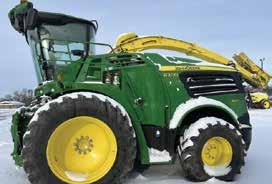










It’s a new year, so I will need to constantly remind myself not to accidentally write 2024 when dating checks and signing documents for the next couple of months. I hope that your holiday season was full of family, friends, food and fun. We did our usual week plus a few days of celebrating Christmas and New Year. I think this year we attended ve separate Christmas parties and shared the gift of sweating together with anyone who wanted to participate. No, I’m not talking about hanging out at Grandma’s house with the heat turned up too high and lots of people crammed in a small kitchen. Emily and I usually give our whole family one big gift to enjoy together as well as everyone getting a couple of smaller individual gifts. The last few years the family gift has been a trip somewhere, but this year we are taking the kids on a family ski trip to Colorado, which they’ve known about because we’ve been planning it for a couple of years. A trip we’ve been planning on doing for a couple of years wouldn’t make a very good gift, but we thought of something almost as good or maybe even better. We bought a portable sauna tent. My friend from college, John Takala, has a dairy farm near Hibbing, Minnesota. Maybe you knew this
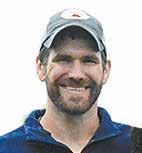
By Tim Zweber Farmer & Columnist
already, but there is a big Finnish cultural inuence from the immigrants who moved there to work in the iron mines. One of the best cultural practices they brought to Minnesota, in my opinion, is the sauna. I mention my friend John because his family has one of my favorite saunas I’ve ever had the pleasure of sitting in. Not because it’s in a picturesque setting on a lake or in an old-growth pine woods. It’s next to their house a couple hundred feet from their calf barn. It’s so neat to me because it’s not a vacation kind of event to re up the sauna and relax after a day of farming; they use it daily. John set a goal to take a sauna every day that he’s not gone from the farm. When I texted him yesterday to check if he’s still doing it, he said he’s on day 1,747. He’s behind his uncle who inspired the goal by a year or two.
With the frigid weather that has been here the last week or so, we are enjoying our new nightly ritual of ring up the wood stove in the sauna after dinner. When we get up to the house from milking cows we head out to the sauna for 20-30 minutes and relax while listening to music and chatting. After we get good and hot we take our time walking back to the house, enjoying the fact that, for at least a bit of our day spent outside, the
negative temperatures feel great. If there was some snow, we’d probably roll around in it. We got to do that the rst day we had the sauna set up before the 40-plus degree days and rain after Christmas melted it all. We had a gorgeous day for hosting the big Zweber family Christmas with everyone outside enjoying the sun and unseasonably warm weather. But the mud that weather made has become an issue. Popping skid loader tires off the rim in frozen ruts is an endlessly frustrating occurrence and always seems to happen at the worst times, generally on Sunday morning when I’m already late getting done with chores and want to get to church.
Until next time, keep living that dream and don’t forget to nd time during or at the end of your day to relax. I hear that lowering your stress levels leads to a longer life, or something like that. That’s probably true, and I bet if health researchers looked into the stress levels of farmers they’d wonder how we live past 40 in the rst place. Maybe hugging cows and calves is as good of stress relief as they say. We’ve never rented out our cows for people to hug or do yoga with, but I bet a number of our herd would love it if we did.
Tim Zweber farms with his wife, Emily, their three children and his parents, Jon and Lisa, near Elko, Minnesota.





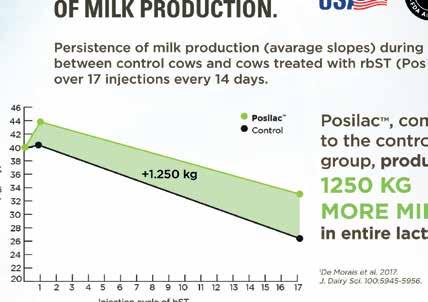



The time of year has come when we eagerly proclaim our New Year resolutions — our goals for the upcoming year. We declare that this year will be the year we nally accomplish the goal. Or perhaps, this is the year we are going to nally quit that thing. However, come February and March, it is often a different story. The changes we were going to make to improve ourselves have already been forgotten and left unaccomplished. Another
The NexGen: Adventures of two dairy daughters

cessful we feel right now is not important. The key is to identify which daily habits are putting us on the path toward success and which are limiting us from greatness.




By Megan Schrupp & Ellen Stenger Columnists
year will come and go and January 2026 will nd us right here where we are now. Making change in our lives is not easy. So what is the key to creating positive changes in our personal lives or on our dairy farms? Creating effective habits.
Habits refer to small actions we perform repeatedly or decisions we make without actively thinking. It is similar to being on autopilot, a technique our brain utilizes to conserve energy. Habits are inuenced by various factors in our surroundings, such as the time of day, location or another activity. Although many habits may seem small and insignicant, they have a profound impact on our personal and professional lives. A small daily habit will compound, creating a huge impact on the trajectory of our life or business. Studies have demonstrated that around 40% of our daily routines are derived from our habits. Therefore, we must ensure that those habits drive us in the right direction.
Identify current habits, both good and bad. What served us well? What actions contributed to our current success? Perhaps a goal or two was missed last year, or we are not currently where we thought we would be. What were the habits that prevented us from reaching our goal last year? What are the things in our daily routine that are not essential to our daily or weekly success? What is contributing to a happy and healthy life, and which are the habits that are holding us back? How successful or unsuc-
Altering habits can be very difcult. It is very easy to focus on what we’d like to achieve in our personal lives or on our dairy farms. Our rst reaction is often to immediately think about the specic action itself that needs to happen to implement change. However, alter your mindset to instead focus on the type of person you wish to become or the type of dairy farm you wish to have. Having a clear idea and focus in mind helps us to more easily intact habits that stack small wins each day to move us in that direction.
Spend time visualizing the systems that will happen before and after the new habit. Anticipate and visualize the challenge that will present itself at the onset and the reward that will happen afterward. Do not focus so much on the habit itself but rather on actions and subsequent feelings that arise just before and those immediately following the action of the habit. It is a process called task bracketing, and it is one of the most proven strategies for developing new habits that persist over time.
Another tool for developing new habits is to consider your daily routine. Placing the most challenging or resisting habits within the rst 6-8 hours after waking is a great way to help make those new habits stick. Research has shown that new habits done early in the morning require fewer days to become automatic.
Finally, nd someone who holds you accountable. Athlete and motivational speaker Inky Johnson says it well, “Greatness is found on the other side of ‘I don’t feel like it.’” Find someone who will check in with you to not only hold you accountable but will also encourage you during times of struggle. Similarly, in our dairy operations, nd a mentor or someone who regularly works with your team to follow up, encourage and remind you of what you want your farm to become in the upcoming year.
We will all have times of trial and tribulation. However, successful people begin and build on successful, daily habits. Let’s start another new year not with aspirations of big goals and achievements, but rather, small, daily, driven habits we preform to make ourselves better today.
Megan Schrupp and Ellen Stenger are sisters and co-owners of both NexGen Dairy and NexGen Market in Eden Valley, Minnesota. They can be reached at Nexgendairy@gmail.com.

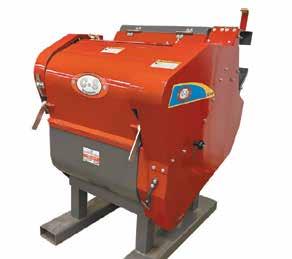
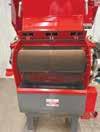



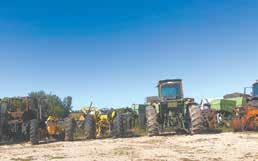
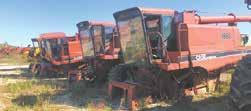



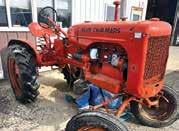

Meet your new winter authority: Kommand™ Guardian
Trust the blue to protect your herd Kommand Guardian is a new non-iodine winter teat dip that packs a one-two punch pairing mastitis-killing power with effective teat conditioning. Exclusive LactiFusion™ technology bonds two effective germicides to help safeguard your milk quality. As the temperature drops, take charge with Kommand Guardian.
teat dip solution
teats from harsh weather against mastitiscausing organisms LactiFusion™ technology
Contact Your Local GEA Milking Equipment Dealer:
Central Ag Supply, Inc.
Centre Dairy Equipment and Supply Inc. Sauk Centre, MN
Eastern Iowa Dairy System
Five Star Supply
Fuller’s Milker Center, LLC.
J Gile Dairy Equipment, Inc.
Leedstone, Inc.
Monroe Westfalia Surge
Seehafer Refrigeration, Inc.
Sioux Dairy Equipment, Inc. Rock Valley, IA
Midwest Livestock Systems
Midwest Livestock Systems –Kozlovsky Dairy Equipment
Stanley Schmitz, Inc.
Tri-County Dairy Supply, Inc.